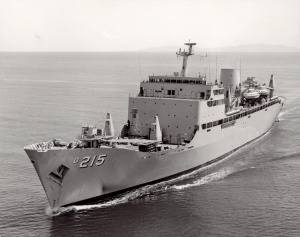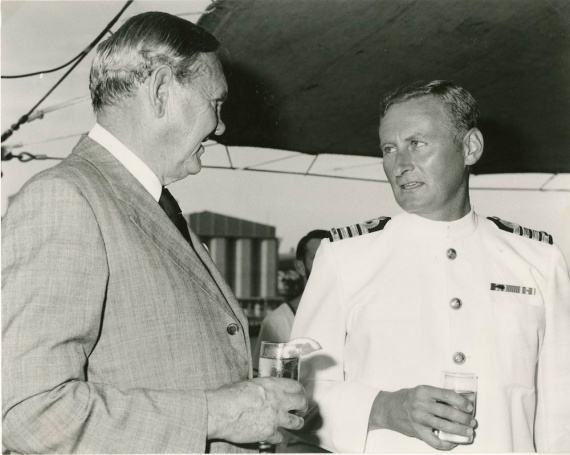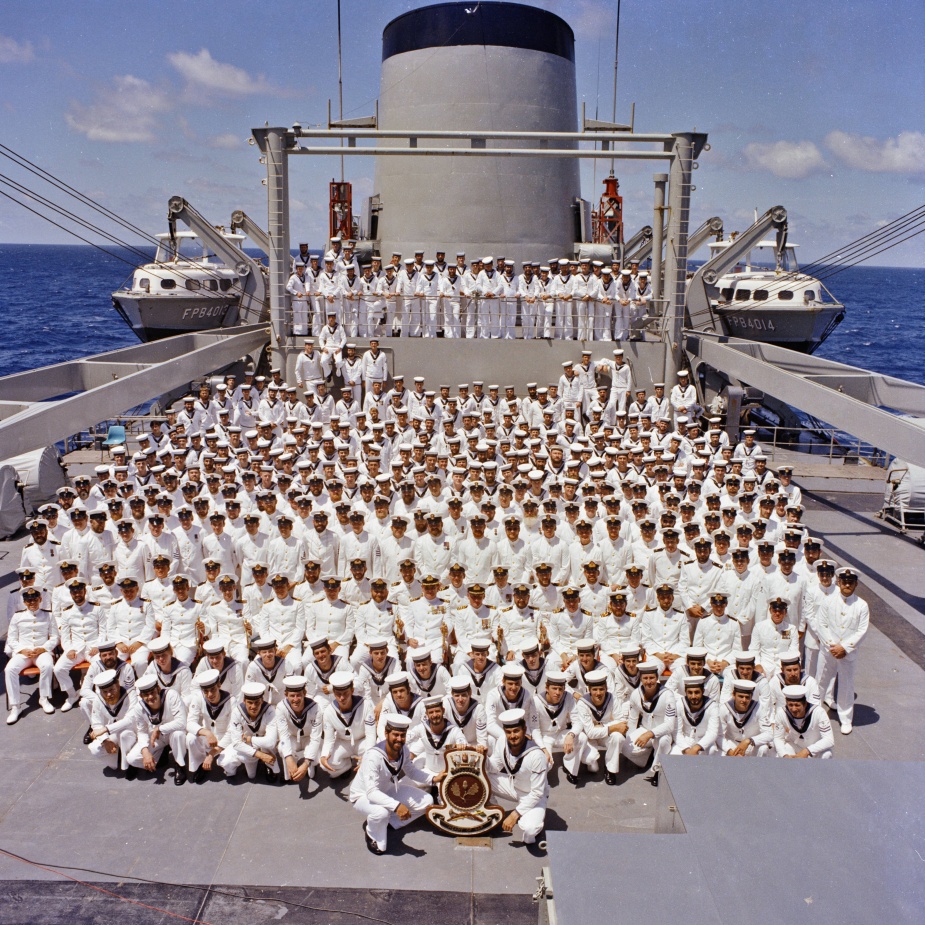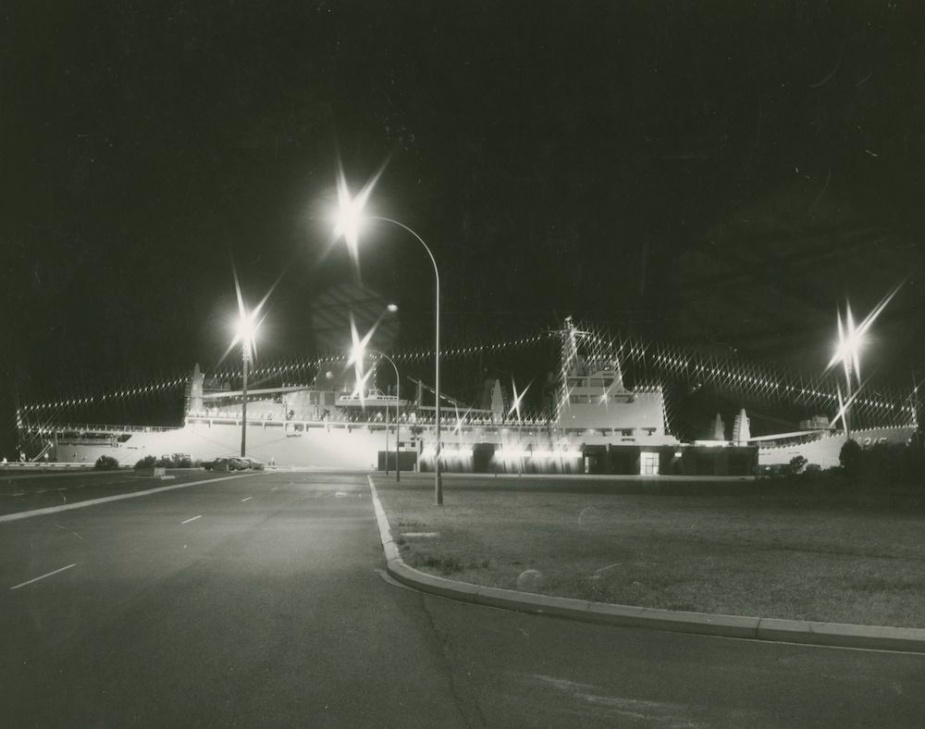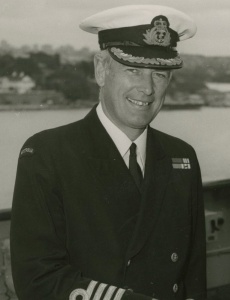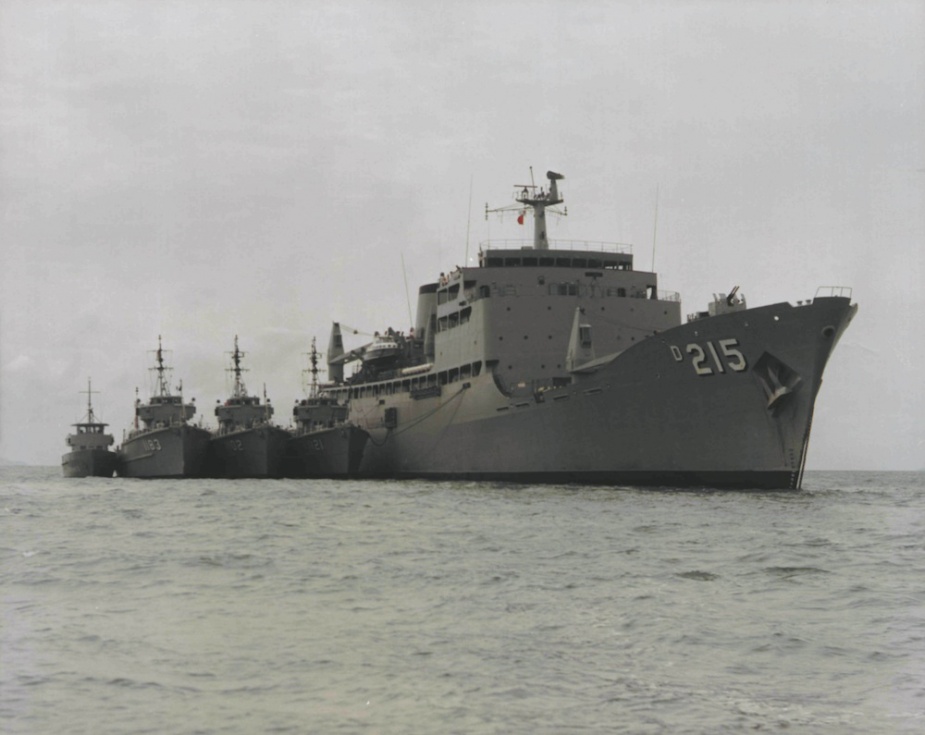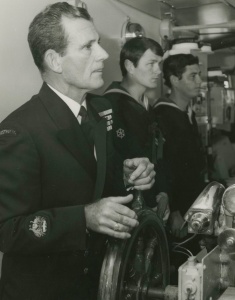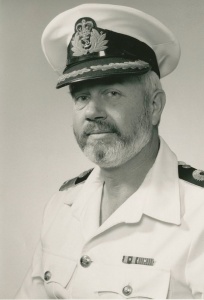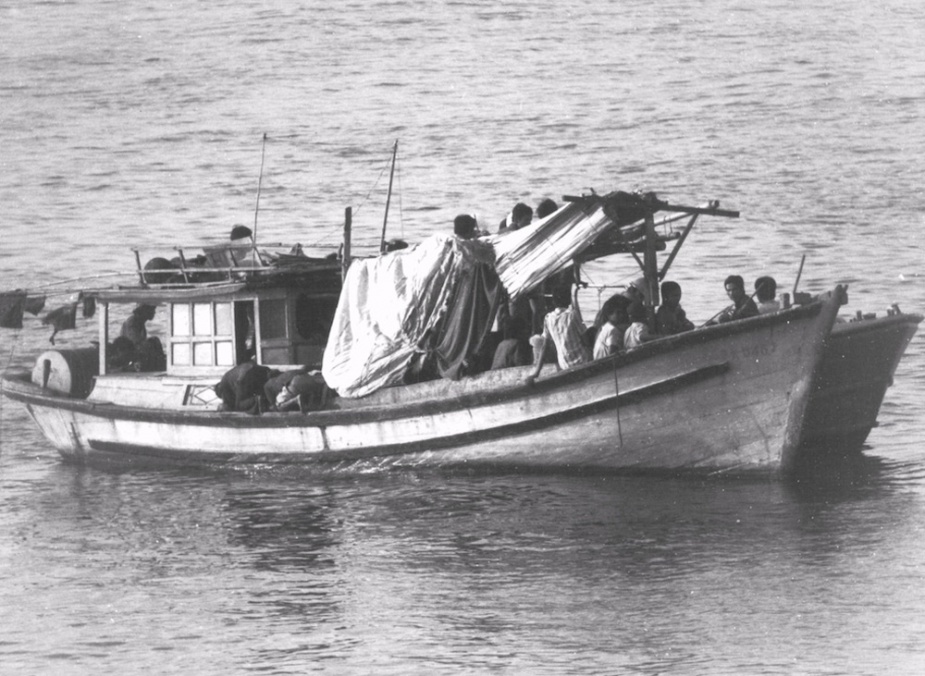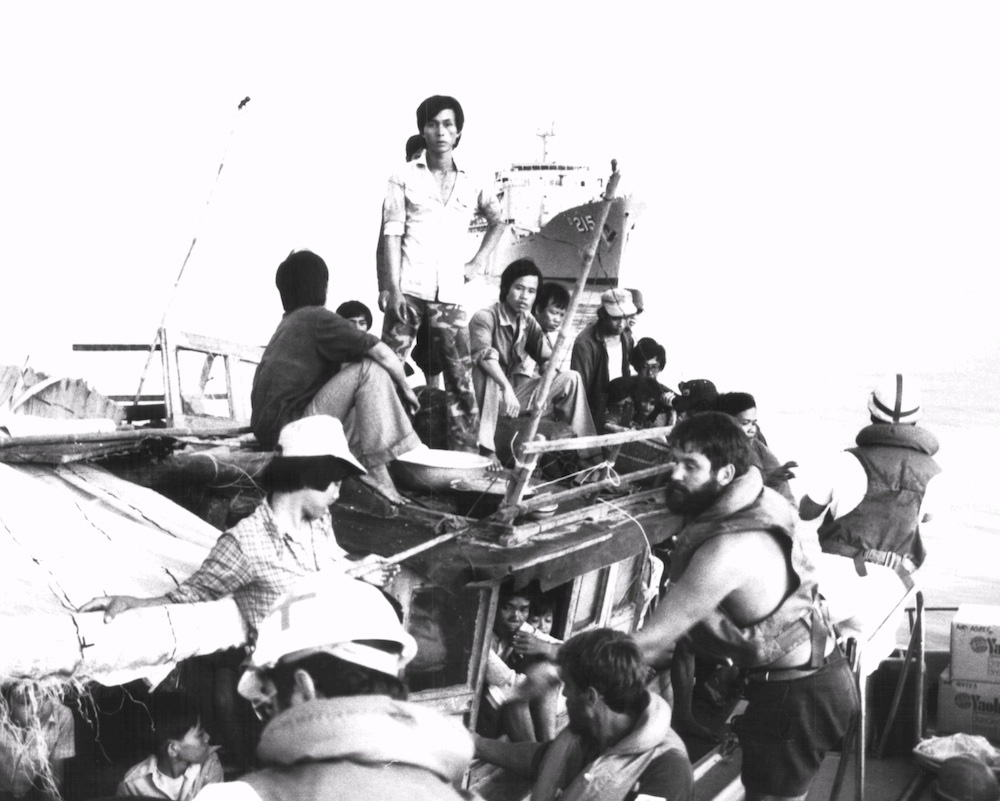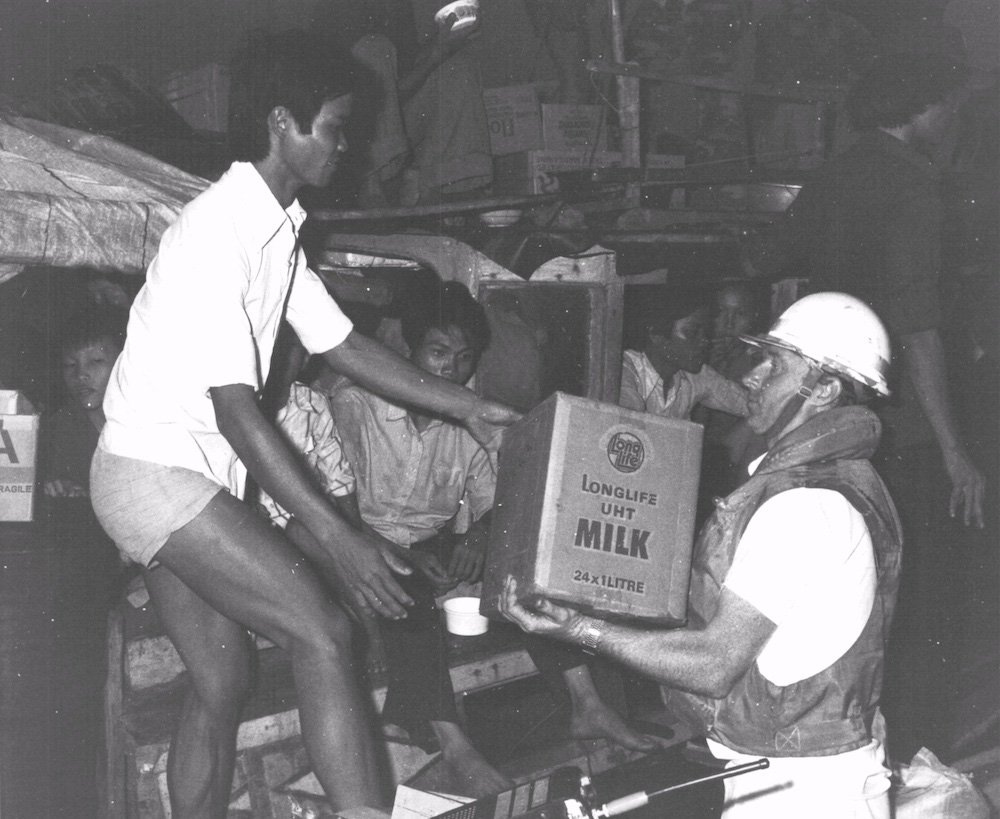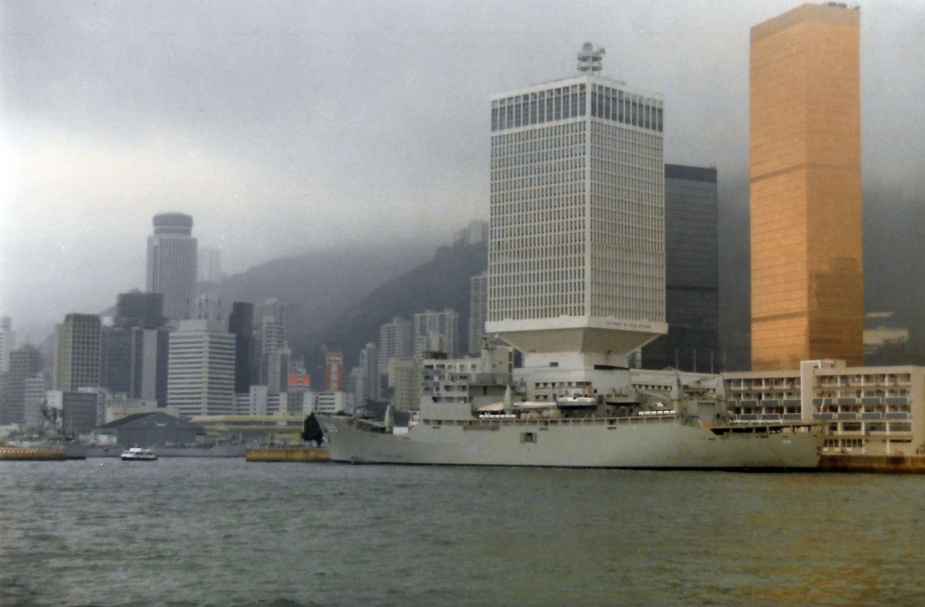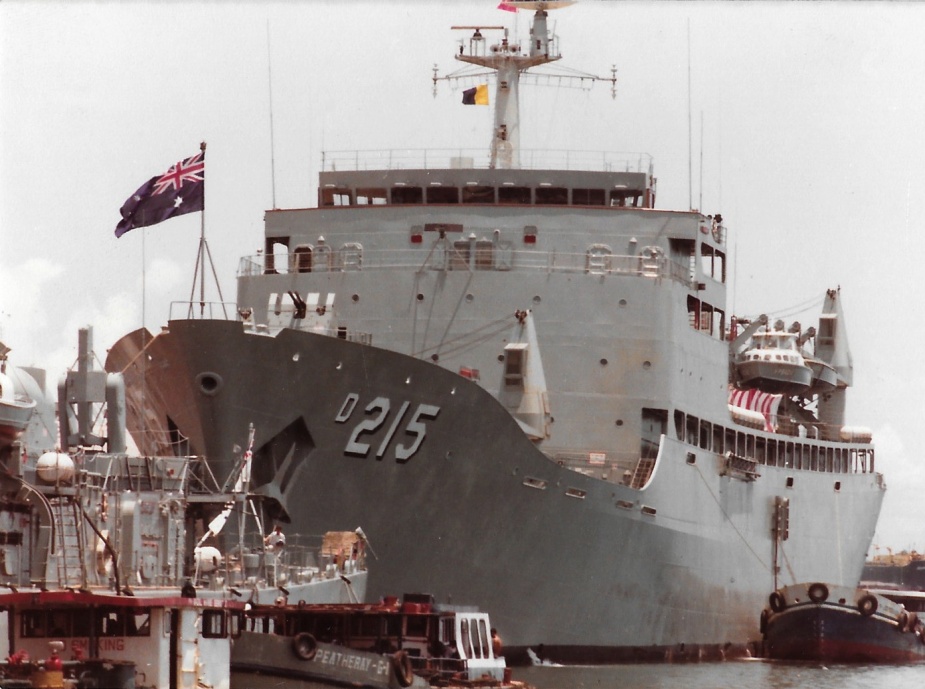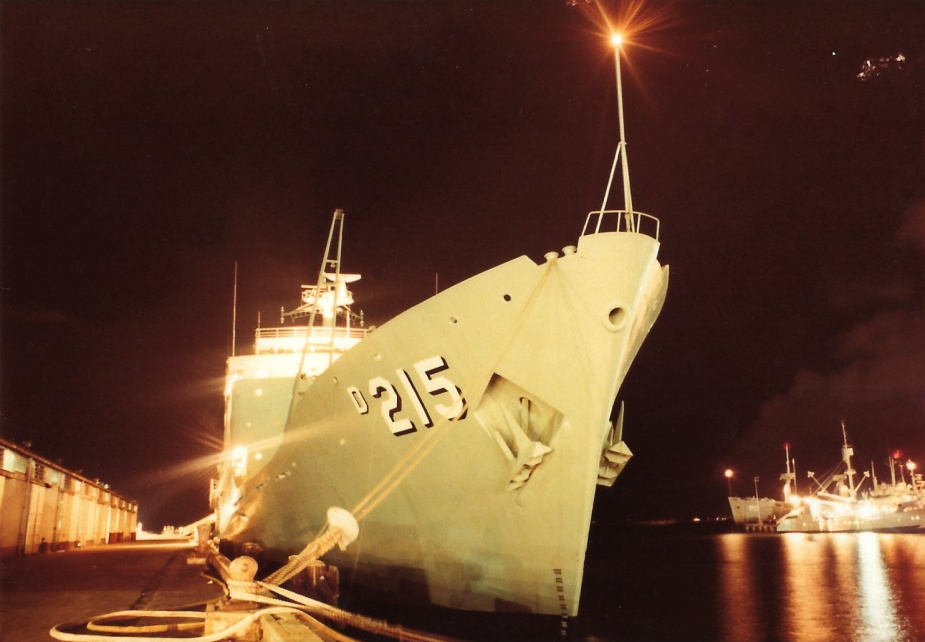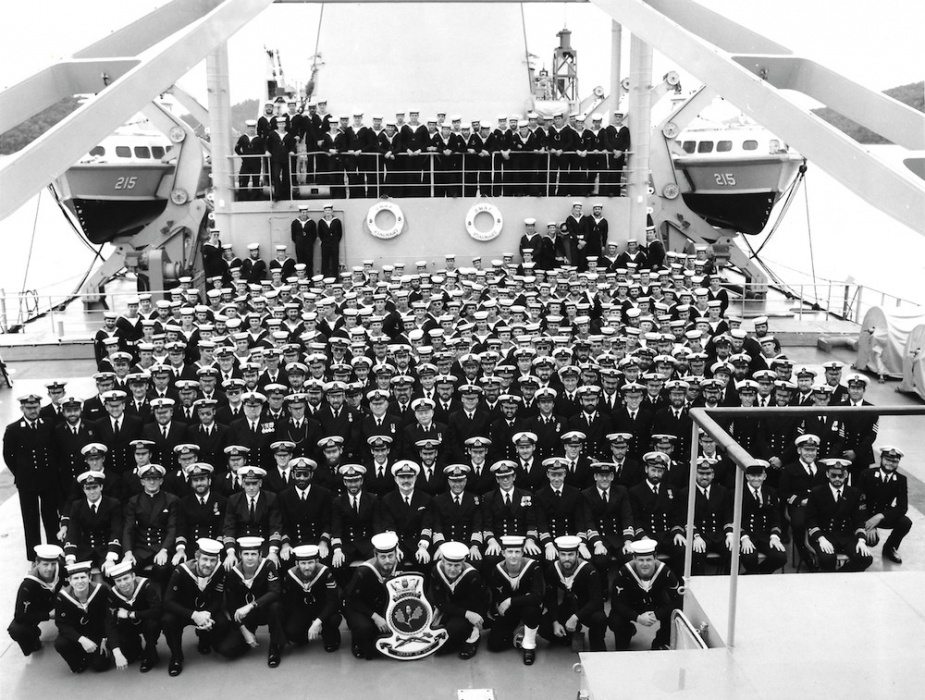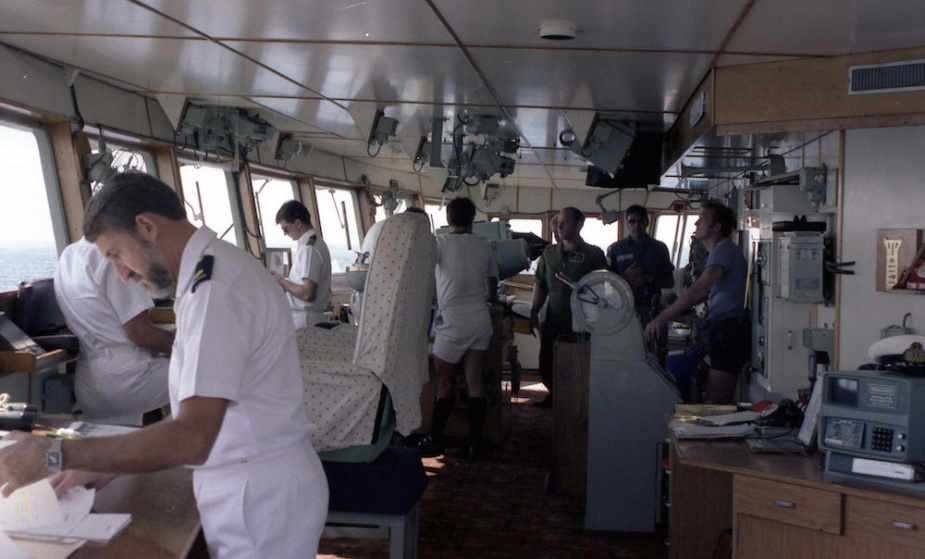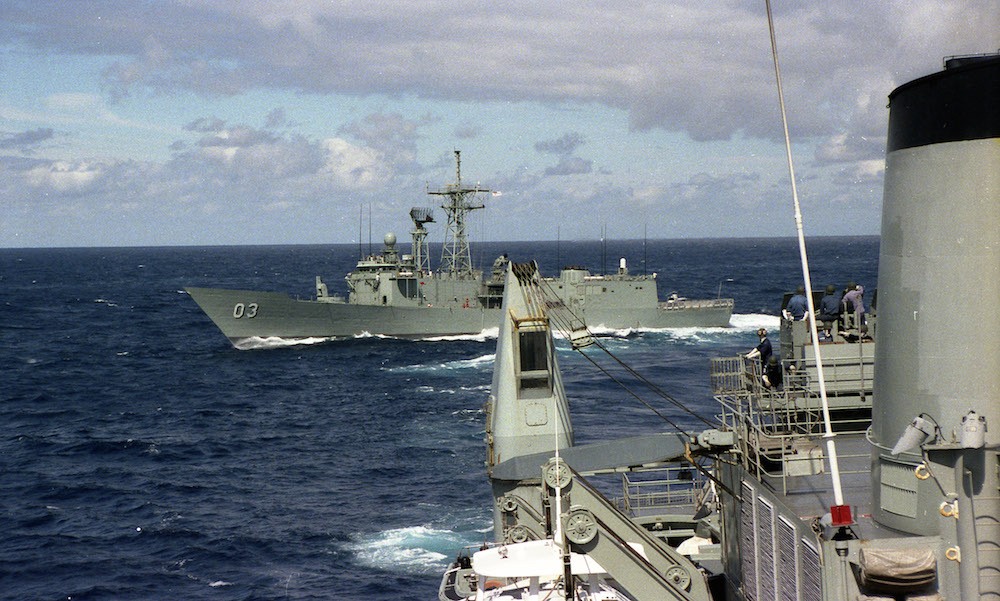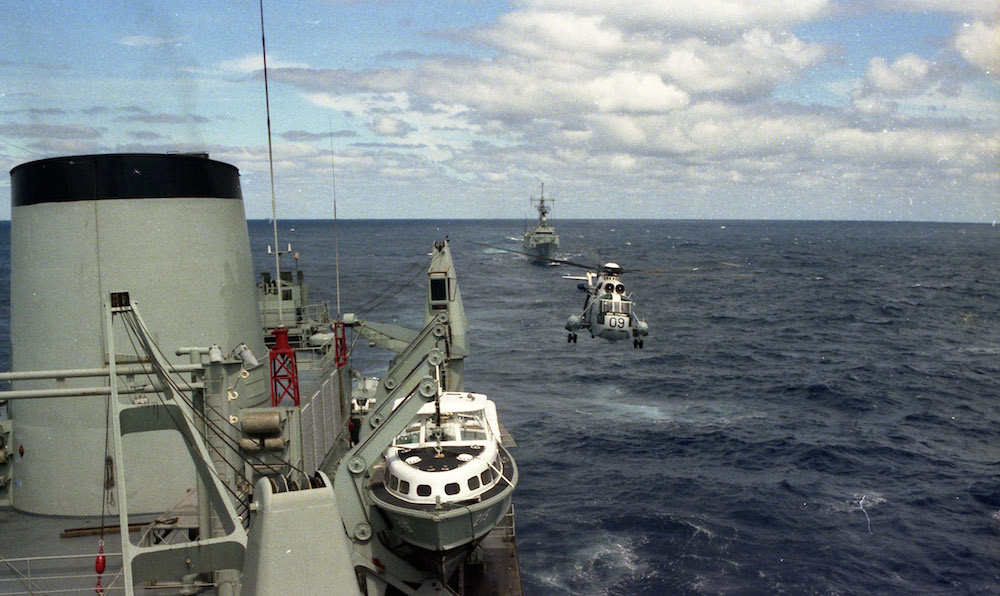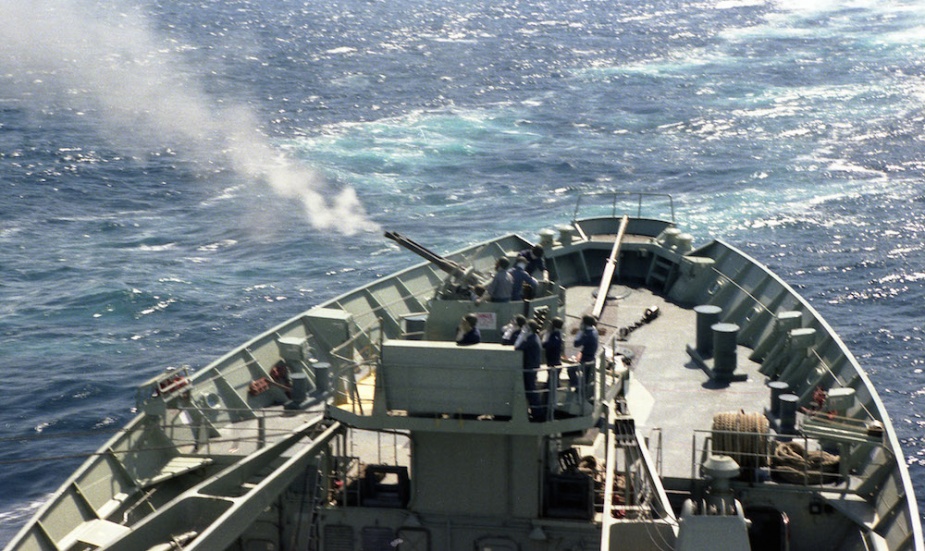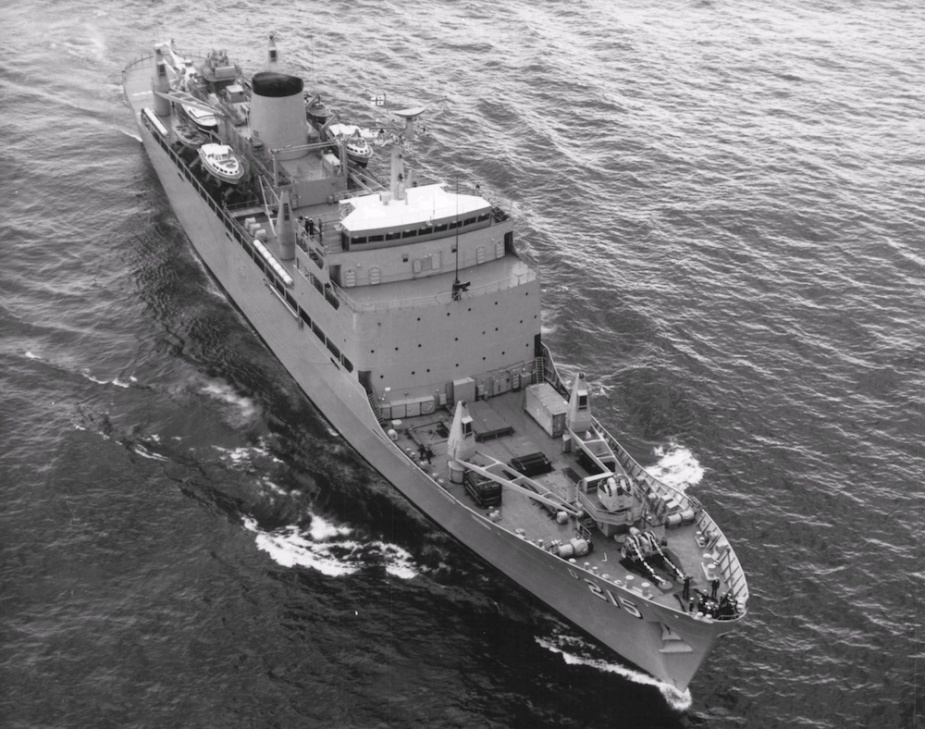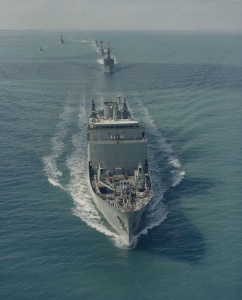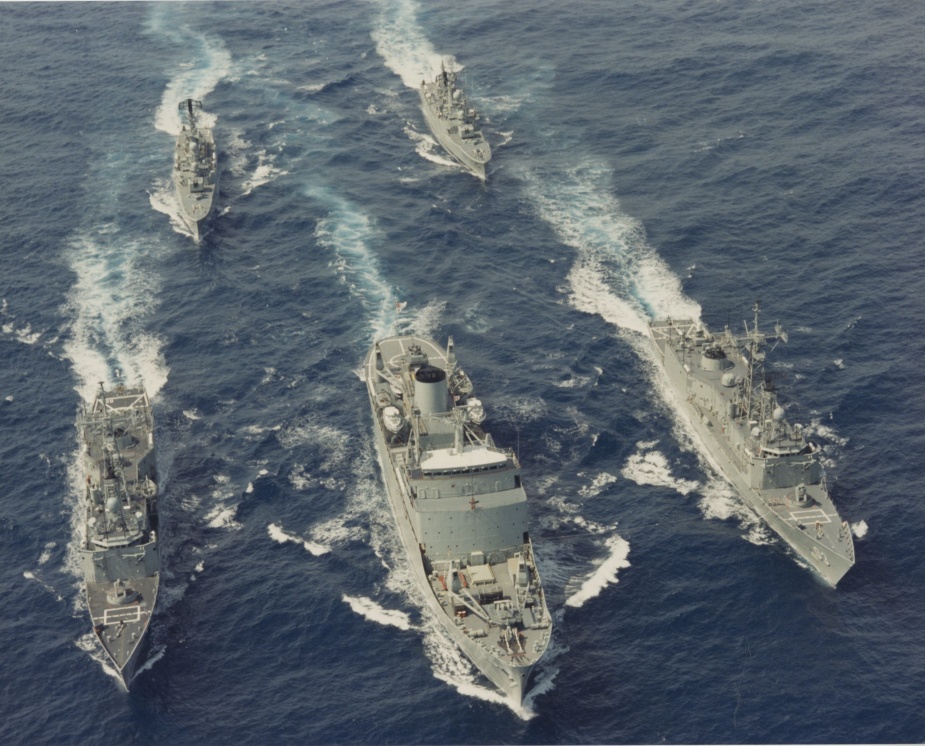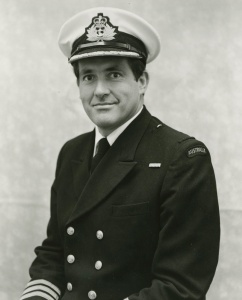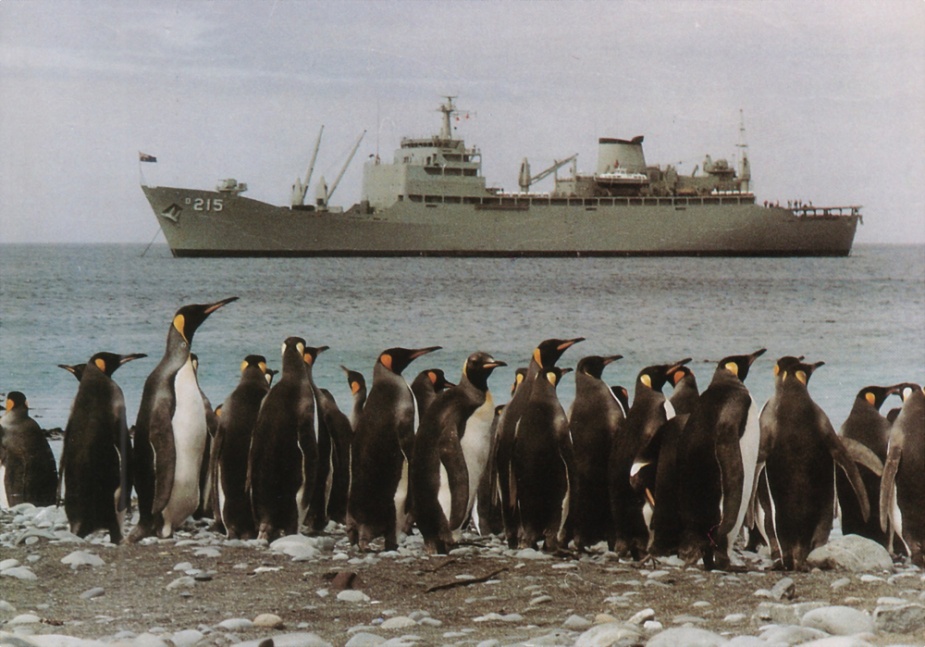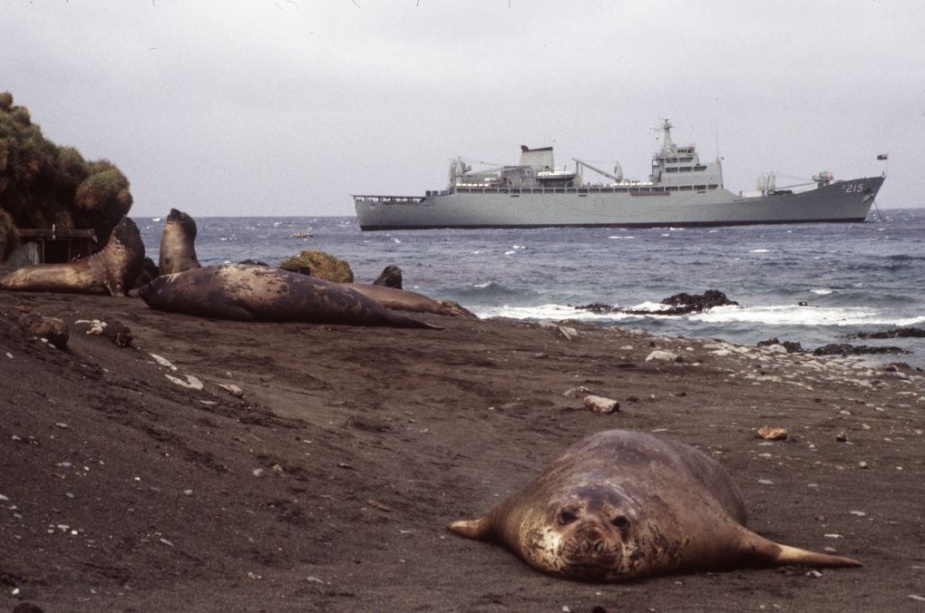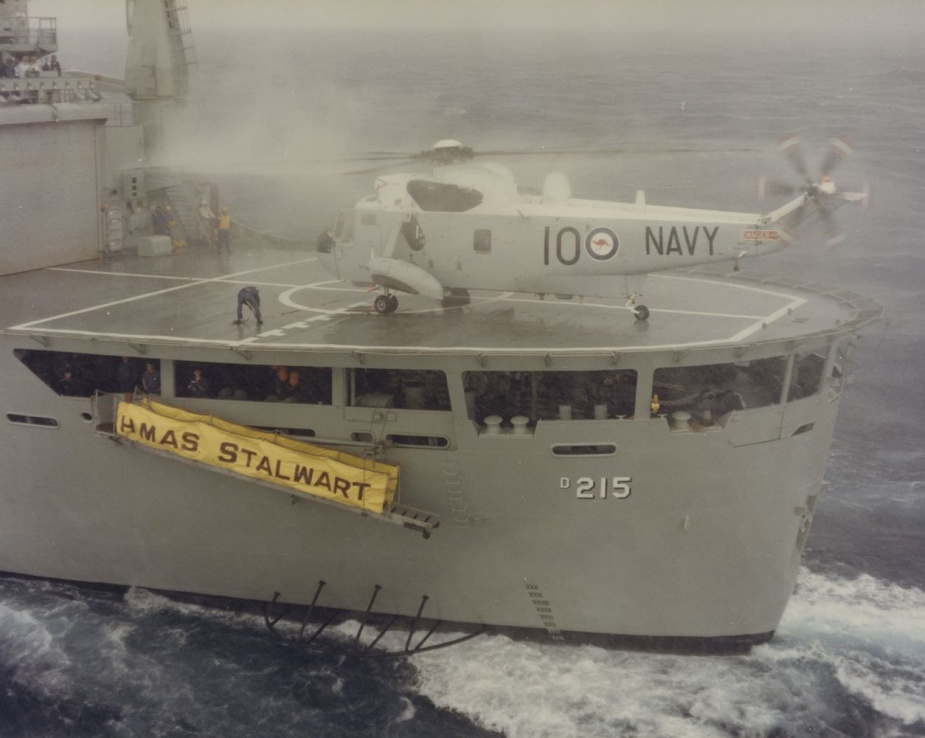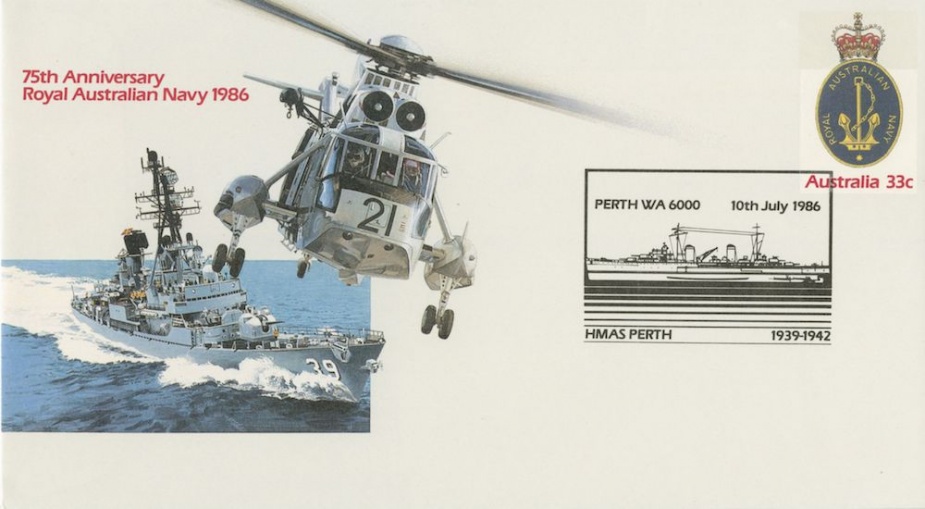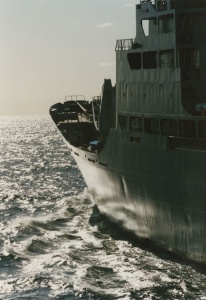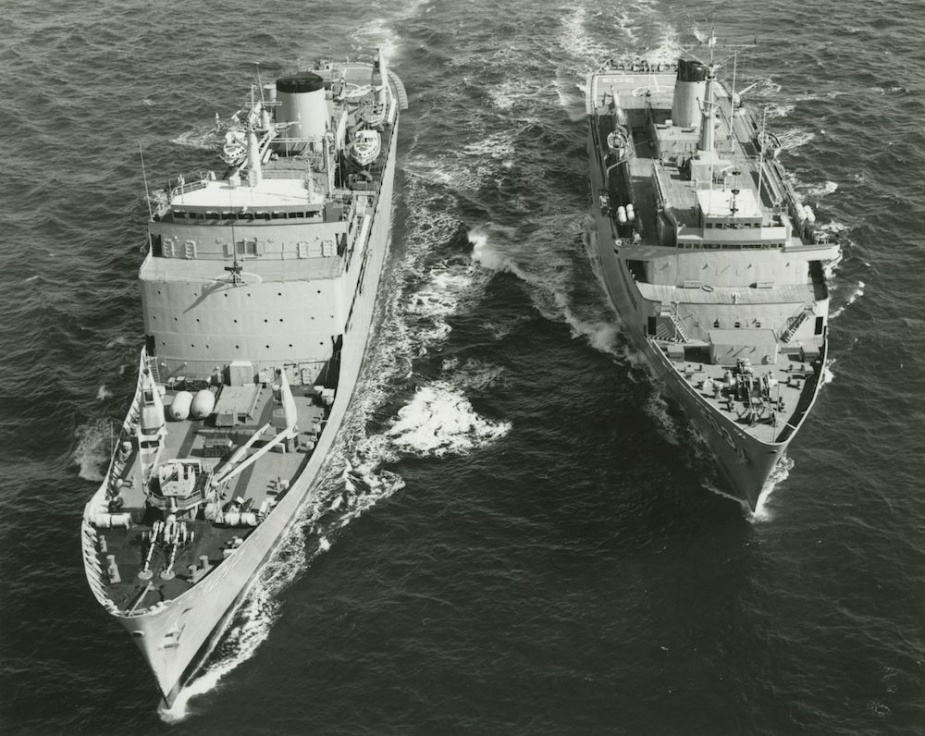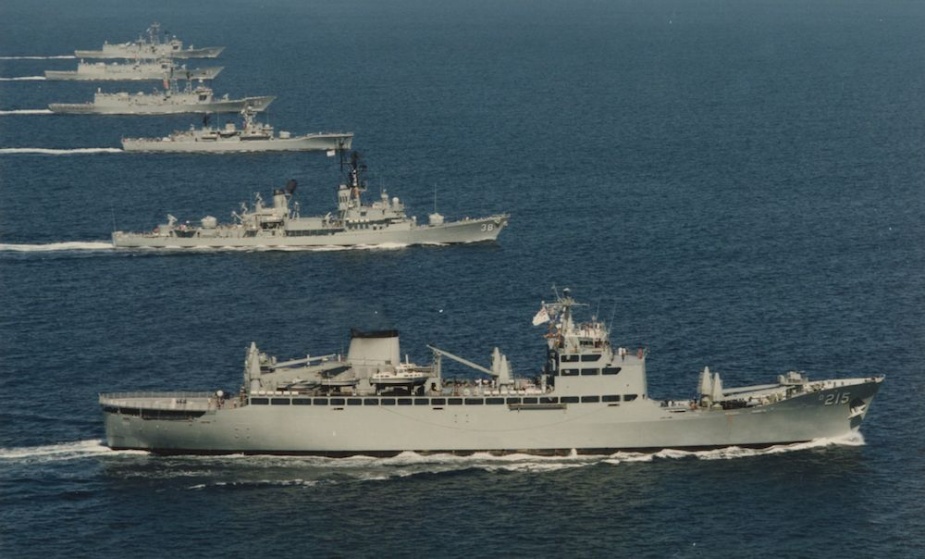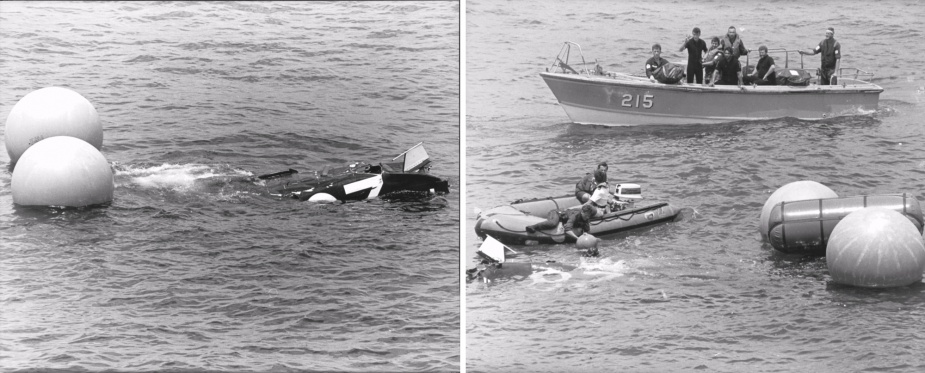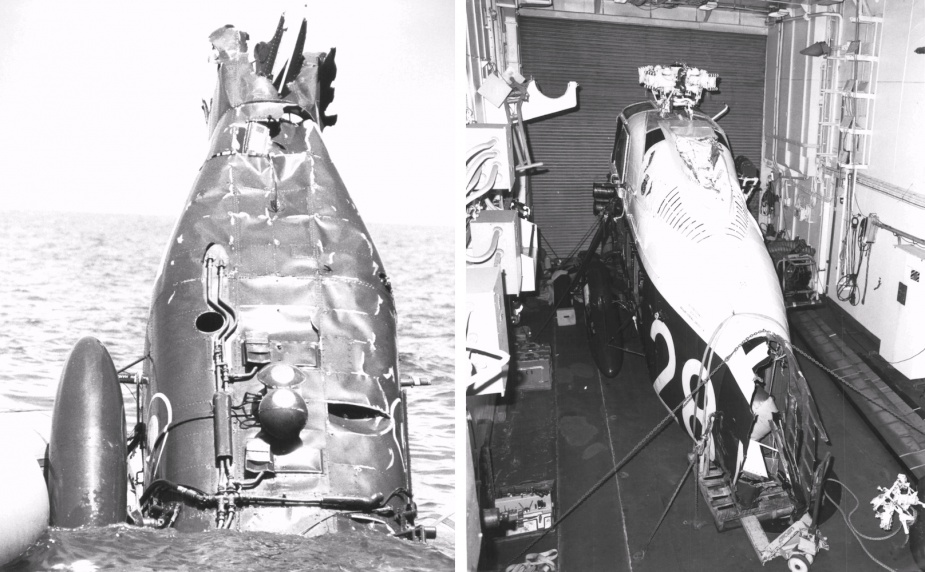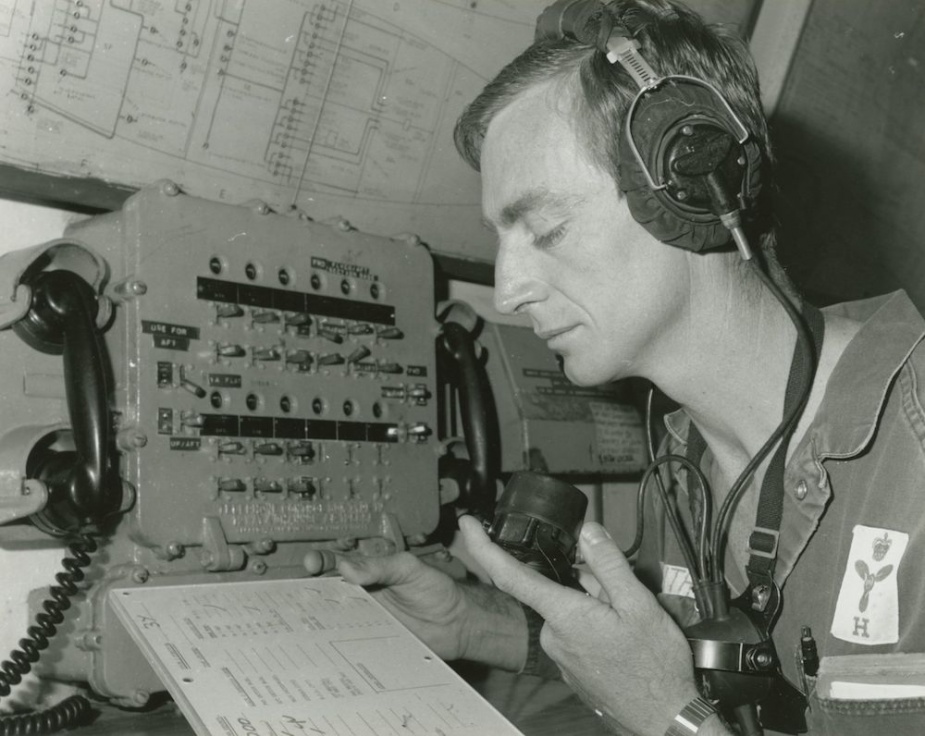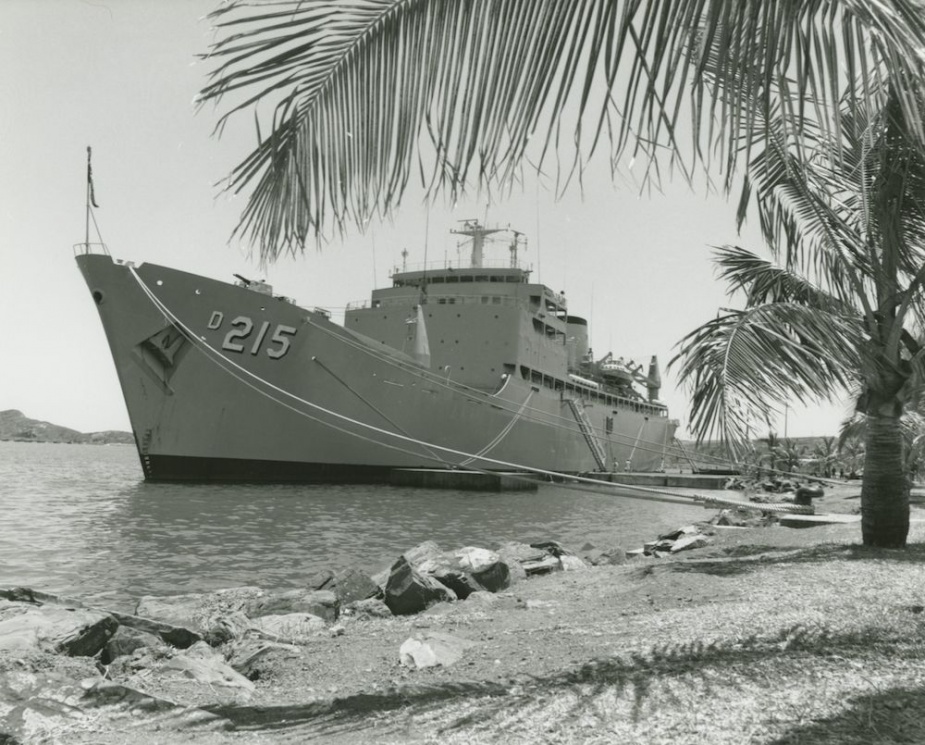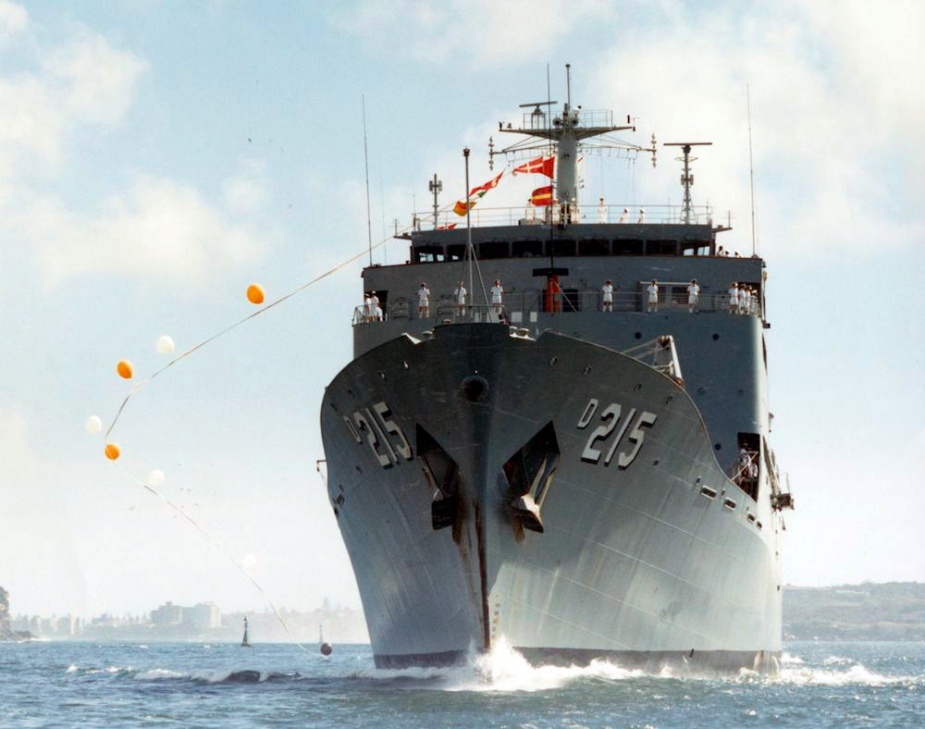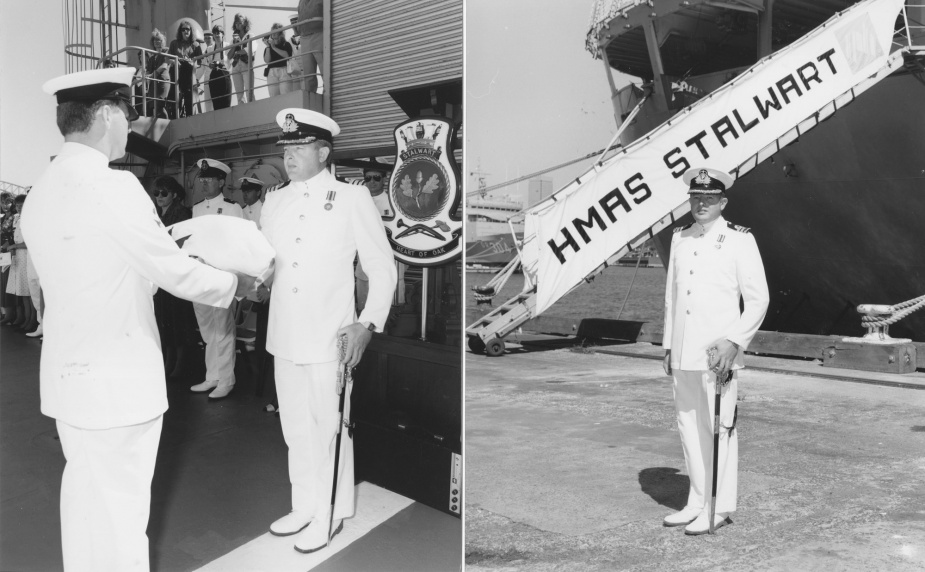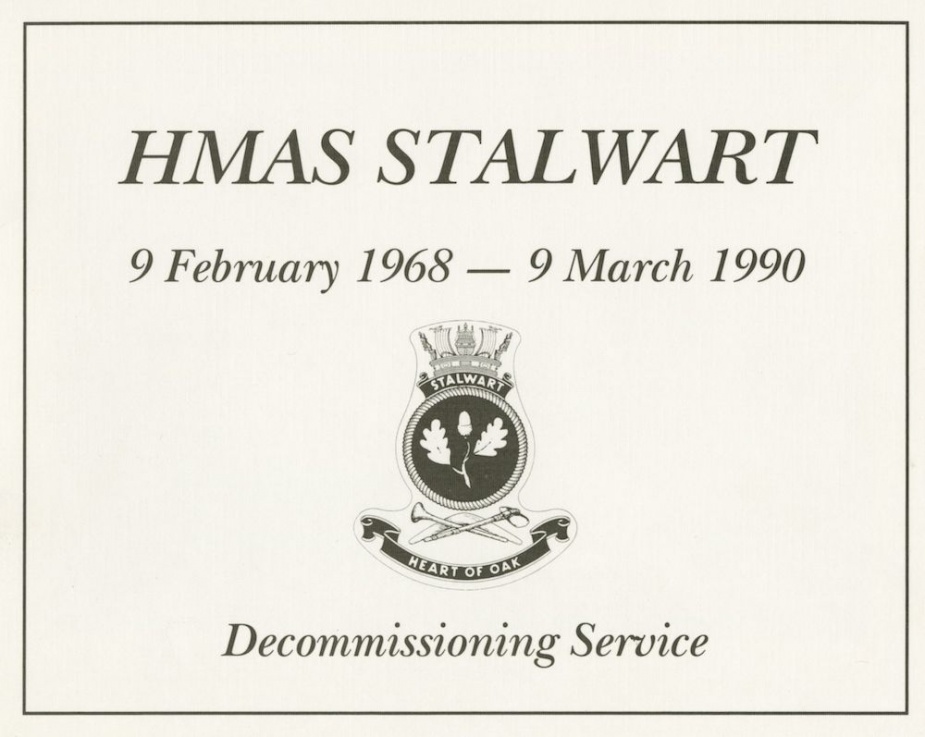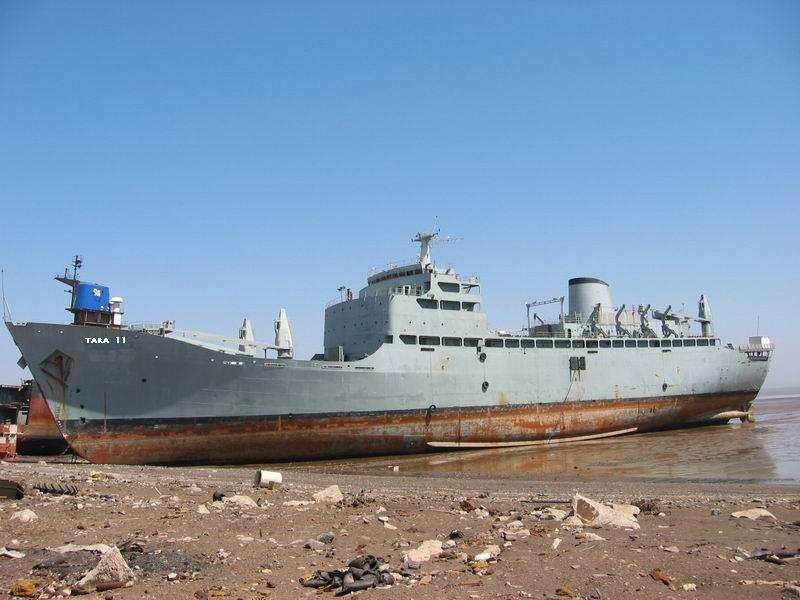HMAS Stalwart (II) - Part 2
| Type |
Destroyer Tender |
|---|---|
| Pennant |
D215 |
| Builder |
Cockatoo Docks and Engineering Co Ltd, Sydney |
| Laid Down |
23 June 1964 |
| Launched |
7 October 1966 |
| Launched by |
Lady Casey, wife of the Governor-General |
| Commissioned |
9 February 1968 |
| Decommissioned |
9 March 1990 |
| Dimensions & Displacement | |
| Displacement | 15,500 tonnes |
| Length | 515 feet 6 inches |
| Beam | 67 feet 6 inches |
| Draught | 20 feet 1 inch |
| Performance | |
| Speed | 20 knots |
| Complement | |
| Crew | 25 officers, 392 sailors |
| Propulsion | |
| Machinery | 2 x 6 cylinder Scott-Sulzer Diesels of 7000 hp driving twin screws, developing 10,740 kW |
| Armament | |
| Missiles | Fitted for, but not with Seacat AA missile systems |
| Guns | 2 x 40mm Bofors AA |
| Helicopters | 1 utility helicopter (Wessex; later Sea King) |
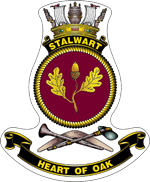
1980
The year began with Stalwart undergoing a Self Maintenance Period (SMP), and finishing Christmas leave.
In late January, the ship deployed to Newcastle for the Australia Day weekend, where former Prime Minister, Sir John Gorton, was a guest of honour. A contingent from Stalwart joined a tri-service parade for the city’s Australia Day Parade. To add to the celebrations, it was learnt that Stalwart’s Supply Officer Commander Rudolph Laing, had become a Member of the Order of Australia (AM) in the Australia Day Honours List.
The ship briefly returned to its home port of Sydney on 1-4 February, before deploying south to Hobart for the annual Hobart Regatta, and celebrating her 12th birthday while in that port. En route back to her home port, Stalwart visited Melbourne and Westernport, with a “sea day” for recruits being conducted at the latter port. An enjoyable family day ended this period of sea time.
The ship next ventured forth in early July, with a port visit to Brisbane, where the change in temperature from mid-winter in Sydney was most welcome. This was followed by a deployment to the Indian Ocean. During the multi-national Exercise SEA EAGLE, Stalwart and Supply, achieved a ‘first’, when Stalwart carried out her first Replenishment at Sea (RAS) with the fleet oiler. In August, while still in Western Australian waters, Stalwart became part of an RAN task group, headed by the aircraft carrier, Melbourne, which was actively involved in Exercise SANDGROPER 80, together with units of the RNZN and USN.
One of the tasks undertaken by Stalwart during the exercise was that of a target towing vessel when the regular towing vessel broke down. Approaching Cockburn Sound on completion of SANDGROPER, Stalwart received an emergency call for medical assistance from a South Korean tanker. In rough conditions a 33-foot sea boat was launched from the ship to the tanker, where patient, Choi Hong Su, was resuscitated and received emergency treatment. After the tanker berthed, the patient was delivered to Fremantle hospital.
As part of the Australian Government's policy of increasing RAN activities in the Indian Ocean, following the Soviet Union’s occupation of Afghanistan in 1979, the task group then sailed for a three month deployment and visiting several countries bordering the Indian Ocean. This was the largest and longest deployment by RAN ships since World War II.
Stalwart, in company with Supply and Perth, arrived in Singapore on 12 September, where they were joined a few days later by Melbourne and Derwent, which had been delayed by weather damage.
During Stalwart’s deployment, goodwill port visits were made to Colombo and Bombay. In Colombo, an enthusiastic working group carried out painting and general interior repairs on the Maharagama Boys’ Home. The hard work and extra hours certainly won a few friends, as a message from the Australian High Commissioner stressed, “We particularly admired the way many of your crew gave up so much of their free time to work on the home...A considerable amount of goodwill has been generated for Australia...”
Following Captain’s Divisions in the Bay of Bengal, Stalwart’s Indian Ocean deployment concluded with another port visit to Singapore during 27 October-3 November; just in time to purchase duty free Christmas presents. The ship finally returned to Sydney on 15 November for Christmas leave. This was definitely a year when the name ‘Building 215’ was not appropriate.
1981
The ship commenced the year undergoing leave and maintenance at Garden Island. This was followed by Stalwart’s almost annual pilgrimage to Hobart (6-11 February) where she acted as flagship for the Hobart Regatta. Stalwart celebrated her 13th birthday while in that port. En route back to Sydney she paid a visit to Melbourne and Westernport.
In late March, Stalwart transited north to Singapore for a Southeast Asian deployment. En route she visited Darwin, for her first visit to that port since early 1975, when she was part of Operation NAVY HELP DARWIN, following the city's devastation by Cyclone Tracy. Stalwart arrived in Singapore on 6 April, undertaking her designed role by maintaining Perth and Brisbane, while in port. Captain Martin de Ville Salmon assumed command of Stalwart on 14 April 1981. During the passage from Singapore to Penang, for a goodwill visit, the ship played host to soldiers of the First Battalion, Royal New Zealand Regiment.
Following a final visit to Singapore in early May, Stalwart returned to Australia ‘westabout’, via Fremantle. On completion of a demanding 11-week deployment, she arrived back in Sydney on 29 May, in time for a scheduled refit.
In mid-October, Stalwart was part of the RAN task group involved in Exercise KANGAROO 81 (K81); a major international exercise off the east coast of Australia, involving 25 ships, 100 aircraft and up to 20,000 personnel from Australia, the US, Great Britain and New Zealand.
This was a busy period for Stalwart, as she had just completed a hurried post-refit ‘shakedown’. Her main K81 role was to coordinate and support Blue Force mine countermeasures and clearance diving operations, with a multi-national team of divers embarked. The task was completed despite the ship suffering two theoretical missile hits. K81 provided yet another insight into Stalwart’s multi-purpose potential. The ship’s year ended in the usual way, in her home port of Sydney.
1982
Following the Christmas leave period, Stalwart visited Port Lincoln, 18-23 February, and Melbourne, 25-28 February, before returning to Sydney for the usual fleet maintenance and support activities.
In late April, Stalwart deployed north to Singapore; visiting Townsville, Darwin and the Cocos Islands en route. This was the third year in succession that the ship had deployed to Southeast Asian waters. While ‘up top’, Stalwart, together with Brisbane and Parramatta, took part in Exercise STARFISH ’82 in the South China Sea.
On 26 June, Stalwart, and other fleet units, made a fleet entry into Darwin Harbour, as part of Darwin’s Navy Week. The ship returned to Sydney on 7 July, resuming her fleet maintenance and support role.
With the decommissioning of the aircraft carrier HMAS Melbourne on 30 June 1982, Stalwart became the new fleet flagship, providing accommodation and administrative support for the fleet staff and fleet band. Given Stalwart’s limited communications fit and lack of an operations room, her function as flagship was for ceremonial rather than an operational functions; but it was nevertheless a demanding new role for this versatile ship.
In 1982, there was a marked change in policy for the conduct of intermediate fleet maintenance within the RAN. This change in philosophy was brought about, in part, because an increasing proportion of the RAN fleet would be ships designed in the USA, which because of their complexity were more cost effective to maintain using onshore support facilities.
The old terms of Fleet Maintenance Party (FMP) and Fleet Maintenance Unit (FMU) were changed to Fleet Intermediate Maintenance Activity (FIMA). As part of this change, Stalwarts FMU changed its title to FIMA (STALWART). Not only did the name change, but also the approach to work. The new FIMA concept was designed to provide the Fleet with a better service, and included a mobile group of technical sailors on standby to travel to where the work needed to be carried out. According to the then Officer in Charge of Fleet Intermediate Maintenance Activity, Commander Watkins, the new mobility would modify Stalwart’s technical complement, with some of her FIMA people no longer traveling with the ship. They would fly out to meet the ship on arrival, use her facilities, and return to Sydney by Royal Australian Air Force aircraft on completion of the task.
Stalwart next took part in Operation SHOP WINDOW, as part of Navy Week 1982. This was followed by a visit to Brisbane to assist with that city’s hosting of the Commonwealth Games. His Royal Highness, the Duke of Edinburgh was guest of honour at a fleet reception aboard Stalwart. The Chief of Defence Force Staff (Air Chief Marshal Sir Neville McNamara, KBE, AO, AFC) later praised the vital participation of the Defence Force in the running of the Commonwealth Games, with more than 1500 service personnel involved.
In early November, Stalwart, flying the flag of the Fleet Commander, together with other fleet units, deployed to Western Australian waters to participate in the multi-national Exercise SANDGROPER 82. On completion of the exercise, Stalwart, and other fleet units, made a ceremonial entry into Fremantle, played into port by the fleet band on Victoria Quay. Christmas 1982 saw Stalwart back at Garden Island Dockyard.
1983
Stalwart commenced the year at Garden Island, celebrating her 15th birthday on 9 February 1983. There was also a change of command ceremony, on 3 January, with Captain's George Unwin and Martin Salmon swapping commands. Captain Unwin moved from HMAS Watson to Stalwart, while Captain Salmon moved from the flagship to Watson.
A Fleet Concentration Period (FCP) in late February started the flagship’s operational year, as she and other fleet units underwent intensive ‘in company’ manoeuvres and weapons training in the JBXA. Participation in Exercise SEA EAGLE 83 followed. This was one of the biggest exercises in recent years, involving the RAN, RAAF, USN and RNZAF in rigorous day and night operations in a simulated multi-threat environment.
Port visits followed, with Stalwart and other fleet units visiting Melbourne (10-15 March), in time for the Moomba Festival, in the biggest concentration of RAN ships in that port since World War II. As a prelude to Moomba, the RAN exercised its Freedom of Entry rights to the city, in a parade involving over 1000 personnel.
Task Group 628.9; Stalwart, Supply, Adelaide, Torrens and Swan, then proceeded across the Bight to Western Australian waters on their way to a three month deployment ‘up top’.
In balmy seas approximately 100 nautical miles east of Christmas Island, Stalwart, alias ‘the Battlestar’, undertook a Replenishment at Sea (RAS) with Supply. This was a special event, in that it was Supply’s 3000th RAS. The ‘Battlestar’ marked the event by dispatching to the fleet oiler, a 3000th RAS cake, whose ingredients included 7kg of fruit and a full bottle of brandy. Supply retaliated with a jackstay transfer of King Neptune and Queen Aphrodite for the mandatory crossing the line ceremony.
Stalwart arrived at Sembawang Dockyard, Singapore on 31 March, having steamed 7203 miles during the month; a record for the ship. On leaving the port five days later, it was generally agreed that despite the devaluation of the Australian currency, Singapore had lived up to its reputation as a good ‘rabbit run’, and sporting venue.
In the South China Sea, while en route to Hong Kong, Stalwart encountered a refugee boat with 74 Vietnamese civilians on board. Once Stalwart’s command team had confirmed the vessel was seaworthy, and its occupants were in good health, they were sent on their way with a working compass and additional food and water.
Stalwart and her consorts berthed at HMS Tamar, Hong Kong, on 10 April 1983. Lieutenant Neville Wyatt, the ship’s Navy News correspondent wrote that:
Hong Kong on top of Singapore does horrible things to a sailor’s bank account...With the bargaining experience of Singapore behind them the assault began, once again, on duty free goods. Rickshaw rides, Star Ferry shuttle runs, visits to Causeway Bay, crowded with junks, and cable car rides to the top of the peak, were popular.
On 12 April Stalwart, accompanied by Adelaide, set sail for Pusan, South Korea, for a goodwill visit under the auspices of the United Nations. The four day passage to that port was often shrouded in fog, and fishing boats in the Taiwan Strait kept the ships bridge team well motivated. On arrival Captain Unwin and the Fleet Commander, Rear Admiral Michael Hudson, were presented with flowers by Korean ladies in national dress, marking the RAN’s first visit to Korea for 15 years.
Official functions included a wreath-laying ceremony at the United Nations Memorial Cemetery in memory of the Australians who died in the Korean War; and a fleet reception, with an excellent beat retreat performance. During the visit, libertymen found bargains at Pusan’s International Markets, with even a Korean version of Monopoly on sale. Trips to the ancient city of Kong Ju, the Punh-Wangsa Pagoda and the Bomun Lake resort were very popular. It was generally agreed that Pusan should be a required port visit for every RAN ship visiting north Asia.
A goodwill visit was paid to the Japanese naval port of Yokosuka, during 21-30 April. Just as Pusan had been Stalwart’s first visit to Korea, this was also the ship’s first visit to Japan. Anzac Day 1983 was officially celebrated with contingents from Stalwart, Adelaide, Torrens and Swan paying a visit to the Commonwealth War Graves Commission Cemetery at nearby Yokohama, followed by the traditional Anzac Day celebrations back at the Yokosuka. The hospitality extended by the Japanese Maritime Self Defense Force and Japanese people were appreciated by all.
The conclusion of the visit to Japan saw the task force heading south with Manila, in the Philippines, being the next port of call. During the eight day passage, Stalwart and the other units participated in a Tri-Navy exercise involving ships and aircraft from the USN and Canadian Defence Force.
With the temperature increasing as the ships sailed back into tropical waters, a change to summer rig became necessary. The task group berthed at Manila on 8 May, to find that Filipino traders had already set up stalls on the wharf, complete with t-shirts bearing the name of each ship. Libertymen from the task group were soon ashore learning to cope with the chaotic traffic including the multi-coloured jeepneys which were the main source of transportation. The tourist trip up the Pagsanjan River was, as usual, very popular, as were tours around Manila, to the San Miguel Brewery and local entertainment spots. A full round of sport was played, with Stalwart’s volleyball team beating all-comers including a Philippines Navy team.
Stalwart and her task group departed Manila on 11 May, staging a ‘mini-war’ en route prior to a visit to Jakarta by the flagship and Supply; with Torrens and Swan having a separate itinerary. The task group finally crossed back into the Southern Hemisphere at 12:40 on Sunday, 15 May. Having transited the Java Sea, Stalwart and Supply arrived in Jakarta for a short goodwill visit on 17 May.
Stalwart and Supply, the big ships of Task Group 628.9, arrived back in Sydney on 1 June 1983, 92 days after their departure, having steamed more than 19,400 nautical miles. This was certainly a year when the sobriquet of ‘Building 215’ was also not appropriate.
Having returned home, Stalwart resumed her designed maintenance activities at Garden Island. The next event of note was the Flagship’s participation in a FCP in the JBXA, involving everything from Officer of the Watch manoeuvres to complex anti-air, anti-ship and anti-submarine exercises, Operation AWKWARD, a Hulkex firing, and finally a ‘mini-war’ with RAAF P-3C Orions, Navy Trackers, Sea Kings and submarines involved. The Fleet Concentration Period concluded with a fleet entry into Sydney Harbour.
When Stalwart was anchored in Jervis Bay during the FCP, a service was held for the late Frank and Edna Eldridge, and their ashes were scattered in the Bay. Mr Eldridge had given a lifetime of loyal service at the RAN College.
The remainder of Stalwart’s year was spent at Garden Island Dockyard. With the ship in Sydney, a small group of Stalwart personnel lent a helping hand with maintenance work at the Penrith primary and infant schools and the local child care centre.
1984
The year 1984 started on a high note for the ship, with the announcement by the Fleet Commander, that Stalwart had won the coveted Duke of Gloucester’s Cup for its overall performance in 1983. This was the second time Stalwart had won this annual efficiency award, the first being in 1968.
The Duke of Gloucester’s Cup was formally presented to the ship in early February by the Governor-General Sir Ninian Stephen. In receiving the award, Captain Unwin praised the ship’s company, “...they wanted to win, that was their aim and they worked towards it. There is a very high spirit in the ship and that counts. Everything is based on spirit.” For 1984, Stalwart’s bridge wings were adorned with the coveted gold star symbol, denoting her status.
For Stalwart, the celebrations continued with her 16th birthday being commemorated in the usual fashion on 9 February 1984. Later that month it was announced that Stalwart had also won the Catering Institute of Australia’s inaugural Silver Platter Award for excellence in food service, thus proving that in 1983, those who “sailed the best, ate the best”. The award recognised the importance of food services (the cooks, stewards, café party, stores naval and stores victualing) in maintaining the morale aboard a warship. The trophy was presented to Commander Murray Forrest, RAN Stalwart’s Supply Officer, who praised the ship’s chief cook, Chief Petty Officer Cook ‘Nifty’ Neville, “I really believe that it was his enthusiasm that helped us achieve excellence. He told me that he was going to win it, the first day I joined the ship.”
Stalwart’s year continued with one of her junior sailors, Able Seaman Medic Gareth Gratton, being awarded the Naval Sickbaymen Association’s training award for his performance at a Health Inspector’s Course.
The flagship’s operational year commenced with an intensive FCP in the JBXA, 13-24 February, which saw 21 RAN ships participating. This was the prelude to Exercise SEA EAGLE, that took place in East Australian waters during 14-21 March, and was followed by a visit to Brisbane.
During the exercise, Stalwart added the role of fleet oiler to her repertoire, when she carried out a Replenishment at Sea with a 10,000-tonne merchant ship (disguised as the patrol boat, HMAS Buccaneer for the exercise). The ‘Battlestar’s’ port after crane was used for fueling purposes; and a length of garden hose, connected to a domestic water tap on the flight deck provided the fresh water. The pumping rate was apparently down slightly on that normally achieved by Supply, and according to the ship’s Navy News correspondent, “Stalwart wishes to inform all potential fleet customers that their rates are reasonable, however it is regretted that furnace fuel oil is not yet available.”
A port visit to Cairns was next on the agenda for Stalwart, followed by a return to Sydney on 11 April, where she remained until 7 May. This was followed by another deployment to Brisbane where the ship and her FIMA supported Tobruk’s maintenance period.
On a cool, overcast 6 August 1984, Task Group 627.2 (Stalwart, Yarra, Canberra and Sydney) departed Sydney on the first leg of an extended Asian deployment, which included visits to Indonesia, the Philippines, People’s Republic of China, Japan, Hong Kong, Thailand and Singapore. This deployment saw the flagship with an 817 Squadron Sea King embarked; the first time this type of helicopter had been aboard for longer than a day.
In what was probably a 'first’ for the RAN, during the deployment, Stalwart, in another demonstration of her versatility, carried a freezer container on her well deck containing 10 tonnes of frozen products for ships in company, to reduce purchase of these high cost products in foreign ports.
The first port of call was Darwin where the task group participated in that city’s Navy Week. While in port, Stalwart’s band performed at a number of venues; the ship’s sportsmen participated in the City to Coonawarra Fun Run and other events, and a live radio breakfast show was broadcast from the ship.
The task group’s first foreign port was Ujung Pandang, the capital of Sulawesi, and Indonesia’s fourth-largest island, during 21-24 August, and although not a pearl of the orient, her libertymen enjoyed the opportunity of going ashore. The fleet band, led by Lieutenant Ashley Greedy, RAN played at Lake Mawang for the official opening of the local rowing championships. Tours of the city, Fort Rotterdam and the surrounding district were popular; and there were bargains to be found at the local markets.
When Stalwart crossed into the Northern Hemisphere on 26 August, His Majesty King Neptune, his ‘beautiful’ wife Aphrodite, and the Royal Court boarded the ship. This was followed by the time honoured inspection and initiation of novices (Pollywogs), together with a number of those of the ship’s company who, although having crossed the line before, were deemed to have blemished their good record by heinous crimes.
Manila, the chief seaport of the Philippines, was next on the task group’s itinerary, with the usual round of official functions, tours, sightseeing, sports and band performances. As usual, the Filipino traders had advance knowledge of the visit, and despite the wet and blustery conditions, had set up wharfside stalls, complete with t-shirts bearing the name of each ship. There was no lack of volunteers to donate blood when the Manila Red Cross visited the flagship. The chaotic traffic seemed worse than previously experienced, particularly after tours to the San Miguel Brewery and local entertainment spots.
Following the Manila visit, it was time for a mini-games afternoon. This was held aboard Stalwart on 2 September in the South China Sea, with competitors from the other ships in company transferring their competitors to the flagship. Worsening weather on completion of the event meant that some competitors had to remain aboard the ship overnight. On 3 September, Sydney and Canberra detached, bound for north Asian ports.
Shanghai, China’s largest city, located on the eastern side of the Yangtze River delta, was the highlight of the deployment. Led by a Chinese destroyer, for Stalwart, Yarra and Stuart, it was a three and a half hour trip up the Huangpu River, through an endless stream of shipping, before they reached their berths.
The flagship’s correspondent recalls:
Upon arrival we participated in a formal welcoming ceremony provided by the Chinese Navy and city officials in which the Fleet Commander, accompanied by the ship’s captains and a contingent from the task group were greeted by a parade of applauding Chinese sailors.
The ship’s Chinese hosts had organised a busy program, including tours of the Wosung Naval Base, a train trip to the city of Suzhou, renowned for its beautiful gardens, and the city of Hangzhou. The fleet band performed an enthralling beat retreat, performed at the Shanghai Conservatorium of Music and even recorded a show for Shanghai TV which had a viewing audience of over 50 million people.
Stalwart had visitors, too; with a visit by 45 members of the Children’s Press, aged between seven and twelve, the editorial staff from China’s youngest newspaper, who would bring their young readers up to date on the state of the Australian Navy. The 5 day visit to Shanghai was definitely a highlight and very much a success, with a Bravo Zulu being received from the Chief of the Defence Force Staff in Canberra. En route to Hong Kong, Stalwart and her consorts engaged in competitive drills. The drills, which had been dreamt up by the fleet staff, were transmitted to all the ships, with the first ship to complete each drill being awarded points.
The task group’s visit to Hong Kong was eagerly awaited, with shopping being the main attraction; not forgetting rickshaw rides, trips across the harbour by Star Ferry, visits to Causeway Bay crowded with junks, and cable car rides to the top of the peak.
During Stalwart’s visit, FIMA carried out maintenance on both Yarra and Stuart, and in keeping with tradition, Jenny’s Side Party painted the ship from stem to stern.
From Hong Kong, the task group passaged south to Singapore, with Stalwart, plus the guided missile frigates HMA Ships Canberra and Sydney visiting the port, while Yarra and Stuart detached to Surabaya. Stalwart’s Singapore visit was another opportunity for her ship’s company to bolster their collection of ‘rabbits’, with an endless collection of stereos and other much sought after items making their way into the many ‘rabbit warrens’ on board.
On 7 October, on passage to Surabaya, and back in the Southern Hemisphere, another highlight of the deployment took place - the Battlestar’s Concert, featuring dixieland jazz courtesy of the fleet band, and guest appearances by ‘celebrities’ flown in especially for the show.
A goodwill port visit was made to the Indonesian port of Surabaya, during 9-12 October, where despite a busy program, the opportunity was taken to provide volunteers for a community project in the town.
From Surabaya, the ships passaged south, transiting through West Australian waters, to participate in Exercise SANDGROPER 84, with Stalwart leading the Orange forces. Midway through the exercise, the ship reverted to her maintenance role to repair Yarra’s port main gearbox in Exmouth Gulf.
Stalwart arrived in her first Australian port leading Brisbane, Torrens, Stuart, Yarra, and HMNZS Waikato in a fleet entry into Fremantle. After a marathon customs clearance lasting four hours, the West Australian ‘natives’ proceeded ashore. During the visit, the fleet band under the baton of Lieutenant Greedy was heavily involved in Navy Week, and the ‘Battlestar’s’ ship’s company attended Commanding Officer’s Divisions, followed by an official ship’s company portrait being taken.
Following a transit of the Great Australian Bight, Stalwart visited Hobart, 10-13 November, where as part of Navy Week, the ship was open to the public with some 2500 visitors taking the opportunity to visit the ship.
Stalwart returned to Sydney on 15 November 1984, 102 days after departure. According to the ship’s cruise book:
Following a two day passage from Hobart...we finally approached Sydney Harbour. There was no lack of volunteers for Procedure Alpha as the ship’s company scrambled for the best vantage points. Family and friends were dockside when Stalwart finally berthed after her leading role in the Task Group to Asia.
Readers may like to know some vital statistics from the deployment:
- Stalwart steamed more than 16,000 miles.
- The supply department calculated that $A1,176,379 was paid in wages, and $A691,414 was exchanged into foreign currency, an average of $1506 per member of the ship’s company.
- The ship’s canteen sold more than 64,000 ‘goffas’, and 13,344 packets of potato chips!
- The Battlestar News Team taped and screened 35 news broadcasts and one ship’s concert.
- 15,800 kg of meat and 12,200 litres of milk were consumed.
Commander David Collingridge, LVO, RAN assumed command of Stalwart on 25 November 1984 and the ship remained at Garden Island for the remainder of the year for Christmas leave and maintenance activities.
1985
Stalwart’s 17th year in commission saw the ship at Garden Island in the middle of her Christmas leave period and Captain Peter Ross, RAN took command on 14 January 1985. Her operational year commenced in earnest with an intensive FCP in the Jervis Bay Exercise Areas (18-28 February), for Fleet Concentration Period 85-1, with nineteen fleet units participating.
Following this energetic start to the year, Stalwart then spent the period 1 March to 24 September at Garden Island Dockyard, undertaking her fleet flagship and fleet maintenance roles.
In August, the RAN entered a new era when Stalwart had a Defence Retail Stores Mini-computer System (DSRMS-N) fitted onboard, thereby becoming the Navy’s first ‘self-accounting’ ship. It is interesting to note that the DSRMS-N unit was even resiliently mounted to counter the ship’s movements at sea.
Stalwart’s long period at Garden Island ended on 24 September when she and other fleet units deployed to the Jervis Bay Exercise Areas, 24-27 September, for a demanding Fleet Concentration Period, the second for the year.
With the completion of the FCP, Navy Week was the next event of significance, with Navy Week 1985 including a ceremonial fleet entry on Friday, 27 September, which saw Stalwart leading 10 RAN units into Sydney Harbour. This not only drew the public’s attention to Navy Week, but also allowed the ABC to secure good video shots for its forthcoming RAN 75th Anniversary TV program. As part of Navy Week, the flagship hosted an official reception that included, in the finest traditions of the service, a beat retreat and ceremonial sunset on the flight deck.
With the headline “Flagship sailor turns to acting”, the 20 September 1985 edition of Navy News informed its readers that Stalwart’s Leading Seaman Jon Dekker had applied his navy skills to the thespian art of acting, recently completing a Sydney season in the Shakespearean drama ‘A Man for All Seasons’. The same article also mentioned that another Stalwart sailor, Petty Officer Geoff Baker, had worked on the production as a lighting technician.
On 8 October, Stalwart and other RAN units departed Sydney bound for, firstly an Exercise SHOP WINDOW, then Exercise CORAL SEA. The exercise saw the end of an era with HMAS Supply’s last RAS. This event saw the flagship and Perth RASing with the fleet oiler, while the fleet band aboard Stalwart played suitable selections. An oversize gold watch was presented by Stalwart to Supply to mark the occasion, the oiler’s 3401st and final RAS. With the RAS completed, Stalwart broke away, cheering ship, and with the band playing Auld Lang Syne.
With the completion of Exercise CORAL SEA, Stalwart was next scheduled to visit Darwin, in company with the guided missile destroyer HMAS Perth, on passage for what was becoming her annual deployment ‘up top’.
On 22 October 1985 disaster struck the flagship which suffered a toxic gas leak onboard which claimed the lives of three of her crew. Sixty others were overcome by fumes and required medical treatment. Those lost in this tragedy were Able Seaman Medic Ian McLachlan, who died on 23 October during the medical evacuation, Leading Seaman Brett Gilbert, who died on 29 October in Prince Henry Hospital, Sydney; and Able Seaman Michael Oliver, who died on 19 November at Prince Alfred Hospital, Sydney.
From Navy News:
AB McLachlan had gone to the aid of shipmates overcome by the poisonous gas leak from the ship’s sullage tanks. He had shared his oxygen mask with his stricken shipmates...The leak occurred as sullage was being pumped from the ship. Gas, thought to be hydrogen sulphide, seeped into the stern gland overcoming two sailors. Stalwart’s Chief Petty Officer Medic David Moss...despatched two medics to the area, including McLachlan. Other sailors working near the area went to render assistance, but they were soon affected by the gas...Oxygen was soon on the scene and a coordinated rescue effort underway...Stalwart called for her helo...to return from Darwin to medevac the sailors...It returned at speed to evacuate four sailors, including McLachlan, who died in transit...Sailors of all rates applied their first aid knowledge to help the injured. The gas affected the respiratory tract and some of the sailors exposed went into severe fits...Ashore, a tri-service and civilian effort had begun to arrange treatment for Stalwart’s men. As time progressed it became clear the gas had affected more people than those in the immediate area of the leak. Nausea, dizziness, numbness in hands and arms, and headaches started to show in more and more people. More medivacs were required. Stalwart’s Sea King made a further four trips to shore as the ship closed Darwin and several Squirrel helicopters from RAAF Darwin joined the effort...to evacuate the sailors to safety. By the time the ship arrived in Darwin on Wednesday, October 23, more than 50 men had been flown from the ship for medical treatment. Stalwart’s Commanding Officer, Captain Peter Ross, said the response of his ship’s company and people ashore was excellent. “The crew were magnificent in the way they looked after their shipmates, at obvious risk to themselves, which was evident later,” he said. “The greatest factor was being able to medevac the sailors ashore.” Stalwart was 200 miles from Darwin at the time of the leak and speed of treatment was vital. The Naval Board of Inquiry...has taken passage in Stalwart to continue their investigation and will be returning to Australia...to gather further information.
Within a week of the incident, an electronic gas detection device was fitted to prevent a recurrence of the tragedy. Able Seaman Michael Oliver was posthumously awarded a Bravery Medal (1 August 1986) for his attempts to save the lives of his shipmates at the cost of his own life.
Stalwart berthed at Sembawang Dockyard, Singapore on 2 November for a short port visit. This was followed by the ship, together with other fleet units, taking part in a major air defence exercise in the Malaysia/Singapore area. The exercise involved other units from Malaysia, Singapore and New Zealand, all signatories to the Five Power Defence Arrangements.
From Singapore the ship proceeded north to Hong Kong, where the climate was a very pleasant change from the steamy, tropical humidity of Singapore. As per tradition, Jenny’s Side Party was employed painting the ship.
A short two day passage saw Stalwart in sultry Subic Bay, during 20-21 November; her last foreign port of call during the deployment, with her crew starting to look forward to Christmas leave. Events, however, were unfolding in the cold waters of Antarctica that would affect the flagship’s program somewhat.
Off Antarctica, the Antarctic supply ship, Nella Dan, was beset in thick pack ice, with no early prospect of undertaking its scheduled mission to resupply the Australian National Antarctic Research Expedition (ANARE) base at Macquarie Island. The sub-antarctic island is a virtual dot of land in the Southern Ocean, situated roughly halfway between Tasmania and the Antarctic continent, some 883 stormy nautical miles south-east of Hobart.
Without such an operation, there could be no changeover of the ANARE personnel, nor could there be an early resupply for the forthcoming winter season. It had been hoped that the icebreaker, Icebird, would be able to free Nella Dan, but she had been delayed by hurricane-force winds and was still battling pack ice over 120 kilometres away, with no guarantee that she would even be able to reach the trapped ship.
Navy answered the request for assistance and Stalwart was diverted for the task, bypassing her home port of Sydney, in favour of Jervis Bay, where stores were loaded, a small RAN video team joined the ship to record the Macquarie Island resupply operation, and 85 crew members disembarked to make room for the stranded expeditioners.
Stalwart arrived in Hobart on 2 December, cunningly disguised as ‘Icebreaker 215’, complete with penguin logos. The much needed ANARE stores were loaded in a non-stop operation, a small media contingent was welcomed onboard, as were the 41 ANARE personnel going to Macquarie Island.
Having transited the ‘Roaring Forties’, with thoughts of the tropical sun but a distant memory, Stalwart arrived at Macquarie Island early on 6 December 1985, in typical overcast conditions. Preceded by two ship’s boats taking soundings, Stalwart entered Buckles Bay, finally anchoring at 08:30, three cables east of the Macquarie Island base.
Macquarie Island’s climate is such that it has an average temperature of just four degrees, with rain, snow or hail on 300 or more days each year. The island is one of the world’s most isolated wildlife sanctuaries, with colonies of gentoo, king and royal penguins, and large numbers of elephant seals.
From the pen of the ship’s Navy News reporter:
Even before anchoring, Stalwart’s Sea King had airlifted the majority of embarked ANARE personnel ashore and preparations were in full swing to shift the large cargo load to the main settlement. On the water, Stalwart’s ship’s boat and her Gemini dinghy were tasked with establishing the fuel line between ship and shore so that 200,000 litres of special fuel could be transferred.
Stalwart had spent some 60 hours at Macquarie Island. The embarked 817 Squadron Sea King was airborne for more than 29 hours, undertaking more than 130 helicopter lifts, landing 200 tonnes of cargo, and making 115 personnel transfers.
With the outgoing Macquarie Island expeditioners safely transferred to the ship by helicopter, the ship weighed anchor, and steamed north leaving the sub-Antarctic waters to the whales, seals, penguins and migratory seabirds. On her way north, Stalwart received a congratulatory signal the Chief of Naval Staff:
FROM CNS AUSTRALIA TO HMAS STALWART ROUTINE MACQUARIE IS. RESUPPLY
R E S T R I C T E D1. I WAS VERY PLEASED WITH THE WAY IN WHICH STALWART MET THE DEMANDING TASK OF RESUPPLYING MACQUARIE ISLAND.
2. WELL DONE AND A HAPPY HOMECOMING.
BT
Stalwart entered Sydney Harbour at 08:00 on 12 December 1985, a sunny day with almost certainly the first warm sunshine the expeditioners had seen for months. Friends and relatives of the ship’s company shared the wharf with the Press, Stalwart’s exploits having captured the attention of the media. Video footage from the embarked Navy Technology Unit video team was included on the television news bulletins that evening.
Stalwart remained at Garden Island mooring for the period 12 December 1985-3 February 1986, for maintenance and Christmas leave.
1986
1986, The year started with the annual visit by the fleet to Tasmania for the Hobart Regatta. On Friday, 7 February 1986, Stalwart and five other RAN units (Hobart, Perth, Darwin, Canberra, Onslow), made an impressive entry up the Derwent River to Hobart, marking the RAN’s 75th Anniversary Year. Contingents from all the surface units participated in the RAN ‘Salute to the City of Hobart’ march to the Town Hall. As part of celebrations, the flagship hosted an official reception that included an impressive ceremonial sunset ceremony. All the fleet units were open to the public during the weekend, with Onslow being the most popular. While in port, Stalwart also played host to Miss Australia and Miss Tasmania. One of the highlights during the visit was the Navy 75th Anniversary Spectacular, staged at the Wrest Point Entertainment Centre, which featured performances by the combined Navy Bands.
A detailed report was released by the Chief of Naval Staff, Vice Admiral MW Hudson, covering the fatal incident aboard Stalwart on 22 October 1985. The report showed that the hydrogen sulphide gas had been formed in the ship’s waste tank by the interaction of oil, chemicals and salt water together with sulphate reducing bacteria. The Naval Board of Inquiry concluded that while one sailor was transferring waste from the tank to the sea, another sailor in a nearby stern gland compartment was pumping bilge water to the sea. Both sailors were using the same pump.
The board concluded that use of the same pump, together with a valve deficiency in the ship’s system, had led to the cross connection of the suction lines and allowed waste to discharge into the stern gland compartment. This had resulted in heavy and lethal concentrations of hydrogen sulphide gas being generated in the compartment. The sailor in the compartment was overcome by the gas, as were five others who went to his aid. Three of the sailors died, but measures to prevent recurrence had been taken. In a follow-up to the fatal gassing incident, former Able Seaman Gary McKay received a commendation from Vice Admiral Hudson for his brave actions during the event.
Stalwart was back in her home port on 21 February, but went to sea again on 24 February for a families day. The period 28 February-6 March saw the flagship and other fleet units in the EAXA for Exercise TASMAN SEA.
Twelve fleet units, led by Stalwart sailed into Melbourne and Geelong on 6 March, to begin southern celebrations of the RAN’s 75th Anniversary year. It was estimated that more than 100,000 people took up the Fleet Commander’s invitation to “share the pride”, and toured the ships during the visit. Many more saw officers and sailors exercise the Navy’s right of Freedom of Entry into Geelong and Melbourne; the latter with an RAN contingent of 1000 personnel leading the annual Moomba parade. The presence of nine surface ships and three submarines in the Melbourne area was one of the largest RAN task groups to visit for over 30 years.
Stalwart returned to Sydney on 13 March, sailing again the next day to participate in a ‘Shop Window’. Following this, the flagship remained in Sydney until 5 May when she sailed to the JBXA. She then conducted a port visit to Port Kembla during 9-13 May.
On 20 May 1986 Cyclone Namu, said to be the worst cyclone to hit the Solomon Islands in one hundred years, swept through the island nation, devastating crops, leaving more than 100 people dead, and an estimated 90,000 people homeless. The Australian Government responded to the Solomon Islands Government request for assistance, and four RAN ships, including Stalwart were directed to assist the battered island state. When Stalwart departed Sydney, she had onboard personnel from Clearance Diving Team One, army personnel and more than 650 tonnes of relief supplies.
The ship’s Navy News correspondent reported:
From the outset of the relief effort, Stalwart under the command of Captain Peter Ross, acted as operational leader. As the flagship waited in Sydney to take on extra supplies, the other ships sailed for the Solomons. On departure from Sydney Stalwart shaped course for Brisbane to embark electricity poles and a variety of other stores. A five-hour stopover was all she had in the Queensland capital before sailing for Honiara, arriving on May 31, with 1000 tonnes of stores. In transit Captain Ross set up operational cells involving medical, technical, supply and operational staff to enable disaster relief tasks to be tackled on arrival. An advisory group ashore, working in conjunction with the Australian High Commission and the Naval Liaison Officer, Lieutenant Commander Darryl Nield, RAN was formed and they detailed the task group to render assistance as required. HMAS Flinders surveyed Honiara harbour to ensure it was navigable, and the Landing Craft Heavy HMA Ships Betano and Brunei arrived on 30 May and 1 June, respectively. The first task for Stalwart was the unloading of stores transported for charity organisations. The Seventh Day Adventist Church had a large contingent on the wharf and they eagerly helped unload bundles of clothing and pallets of food supplied by their counterparts in Sydney, and the food supplied by World Vision and the Marist Brothers. The tasks assigned to Stalwart included resupply of the other ships in the task group so that they could continue their setting up of food dumps and the resupply of isolated villages. Tasks carried out by the ship’s companies included: delousing, refrigeration repairs, supply of food and medical assistance to the Honiara Community Hospital; assistance with setting up a refugee camp and disinfecting the area, spraying for mosquitoes and then supplying food and stores; assembly of power poles and a transformer so power could be supplied to Guadalcanal; aerial survey of areas of devastation and food and personnel transfers carried out by Stalwart’s Sea King helicopter.
The Minister for Defence later praised the RAN relief efforts, as did the Chief of Naval Staff, Vice Admiral Hudson:
I have been most pleased with the way the fleet and all the support elements have responded to the disaster attending Cyclone Namu...I commend the cheerfulness, alacrity, initiative, enthusiasm and sheer hard work of everybody concerned. I add my own well done to the evident appreciation of the government and people of the Solomons.
In mid-June the flagship departed Sydney, joining other fleet units on passage to West Australian waters. The first port of call was Adelaide, where 200 guests attended a cocktail party aboard Stalwart. During the visit, over 6000 people also visited the ship. On 30 June, an RAN contingent from the visiting fleet units marched through Adelaide to be reviewed by the city’s Lord Mayor. Other highlights of the visit included visits to the Barossa Valley, with one group from Stalwart travelling in style, in two hired Mercedes limousines. A concert by the combined fleet and Victorian bands under the baton of Lieutenant Commander Bill Farrell, with vocalist Lieutenant Julie Miller, performed at the University of Adelaide, and received a standing ovation from the audience.
After a stormy transit of the Great Australian Bight, Stalwart berthed at Fremantle for a six day visit (8-14 July). The visit followed the normal format with a cocktail party, sporting events and other functions. One notable event was a commemorative service held on the boat deck to celebrate the RAN’s 75th Birthday. This was followed by the launching of Australia Post first day covers featuring naval scenes. A number of these had been delivered to Fremantle by HMAS Geraldton, transferred by Sea King helicopter to Stalwart and then handed over to the Australia Post state manager, by Commodore Malcolm Baird, RAN.
Following the Fremantle visit, Stalwart sailed to Fleet Base West where she was used by the Special Air Service Regiment as a training venue for anti-terrorist exercises.
With this completed, the ship sailed for Darwin, with the passage interrupted briefly at the North West gas fields, to allow members of the ship’s company to visit the North Rankin A Production Platform.
After Darwin, Stalwart next called at Goods Island, where items from heavy guns from the lights cruisers Melbourne and Sydney were recovered. Most parts were too heavy even for the Sea King to lift, so recovery was limited to the training mechanisms, gun recuperators and various other lighter items. On completion of this evolution, Stalwart shaped course for Sydney.
On 15 September 1986, to help the Royal Australian Navy celebrate its 75th Anniversary, Prime Minister Robert Hawke took his Federal Cabinet to sea aboard the flagship for what was the first Cabinet meeting at sea. When members of the Cabinet disembarked, it was noted that some Ministers were in better health than others; three in particular had obviously suffered from sea sickness during the day.
Leaders from around the world sent congratulatory messages to the RAN as preparations for the 75th Anniversary naval assembly and review in Sydney Harbour moved into their final stages.
The RAN’s 75th Anniversary was celebrated on Sydney Harbour in glorious spring sunshine on 4 October 1986. Forty one RAN vessels and warships from six nations took part, with the flagship being alongside at Garden Island. His Royal Highness Prince Philip reviewed the warships aboard HMAS Cook, which sailed around and between the lines of assembled vessels. The finale came that evening with a spectacular pyrotechnics display over Sydney Harbour, culminating in a ‘waterfall’ of fireworks pouring off the Harbour Bridge.
Prince Philip, Prime Minister Hawke, Members of Parliament and the public subsequently praised the RAN for the finale to its anniversary year.
It was perhaps belated comfort to Stalwart’s crew that Able Seaman Michael Oliver’s self-sacrifice was acknowledged when Her Majesty the Queen approved the posthumous award of the Bravery Medal (BM) for his actions on board the ship during the gassing accident on 22 October 1985. The citation reads:
HMAS Stalwart was 210 miles north east of Darwin when Able Seaman Oliver became concerned about the odour of the waste he was pumping overboard. He shut down the pump and then saw two sailors collapsed in the compartment below. He immediately raised the alarm, collected breathing apparatus, put one on and, with another sailor, took a spare into the compartment. By his actions Able Seaman Oliver displayed considerable bravery, thereby losing his life.
Stalwart paid a visit to Newcastle, 15-16 November 1986, where the crew took part in the Surfest 86 festivities, and the flagship provided an added attraction to the event. Some 3600 Novocastrians visited the ship, and showed great interest in the ship and the flying displays by the ship’s Wessex helicopter. Dial-a-Sailor was in operation during the visit; other activities included a Ship’s Dance and a winery tour of the Hunter Valley vineyards. All in all, the weekend was a great success in promoting the Navy in the Newcastle region.
About 40 members of the ex-Naval Association, Australia Day Council, plus Naval Reserve Cadets, and former and serving WRANS, and media representatives, were invited to searide for the trip back to Sydney. The end of the RAN’s 75th Anniversary year saw Stalwart alongside Sydney’s Garden Island Dockyard for leave and maintenance.
1987
Captain Bryan Wilson, RAN took command of the ship on 23 January 1987 and she sailed on 9 February for a short visit to Hobart. The date was also anniversary of her commissioning; and her nineteenth birthday was celebrated with the traditional birthday cake; which was cut by the youngest member of Stalwart’s ship’s company.
Anzac Day 1987 saw the flagship and the guided missile frigate Adelaide, in Auckland, the first port of call on a 6000-mile deployment. The goodwill visit included the traditional Anzac Day march by an RAN contingent, plus the fleet band, and a heavy round of social and sporting commitments.
As part of the Australian Government’s commitment to strengthen relations with its Pacific neighbours, the two ships visited Suva (the capital of Fiji), Tuvalu and Vila in Vanuatu, which was still recovering from a cyclone. Work was done on 40 individual projects in the three nations, including work under the Defence Cooperation Program. En route to Fiji, the two ships, plus two patrol boats and the guided missile frigate Sydney, participated in Exercise PACIFIC GRANDEUR, operating with RAAF and RNZAF aircraft.
A short goodwill visit was made to Suva and, while alongside, a group of personnel from Stalwart started work to repair a crippled children’s home. Stalwart next visited Tuvalu, some 600 miles north of Fiji, to work on civil aid projects, when the news broke regarding a military coup in Fiji which saw Lieutenant Colonel Rabuka of the Royal Fijian Military Forces, overthrow the recently-elected Bavadra government. This event saw the Federal Cabinet discussing contingency plans for the possible evacuation of Australians from Fiji. With this in mind, the ship’s return to Australia was delayed, and she was diverted to Suva. Other RAN units also remained in the area, or deployed from Australia, as part of Operation MORRIS DANCE.
Stalwart finally departed Suva on 30 May 1987 and, after a rendezvous and transfers with Success, departed for return to Sydney, leaving Success and Sydney on station off Fiji.
The ‘Battlestar’ then undertook a scheduled docking in July, followed by trials and workup in the East Australia Exercise Area in early August.
The ship visited Cairns and Townsville during late August and early September. Brisbane was next on Stalwart’s itinerary (11-16 September), where the ship took part in the city’s Navy Week celebrations. Continuing south, she returned to Sydney for a Self Maintenance Period and taking part in Sydney’s Navy Week 1987 celebrations. This was followed by a visit to Melbourne, 30 October-7 November, for the Melbourne Cup; and a visit to Adelaide during 9-16 November.
Stalwart returned to Sydney for leave and an Assisted Maintenance Period, remaining in Sydney until 6 January 1988.
1988
Stalwart’s year commenced with the ship at Garden Island for leave and maintenance. The ship’s operational year started early, with a passage to Hobart, 6-8 January, together with Hobart, Canberra and Adelaide, to support the Tall Ships Race, which was part of Australia’s bicentennial celebrations. Brilliant sunshine greeted the tall ships as they sailed up the Derwent River, to be greeted by huge crowds and a program of receptions, presentations, a mardi gras at Hobart’s Salamanca Place, and a march through the city. Stalwart had the privilege of being the reviewing platform for the tall ships parade of sail, with the fleet sailing past the ship to be reviewed by the Governor-General, Sir Ninian Stephen and Lady Steven.
On completion of their Hobart visit, the RAN ships monitored the 170 vessel tall ships fleet during their voyage to Sydney. On 16 January, Stalwart responded to a distress call from a sailing craft, which was in danger of sinking. After a portable diesel pump was transferred to the craft, it was pumped dry and towed into Eden by another yacht.
The flagship was back in Sydney in time to lead an impressive fleet entry into Sydney Harbour. She remained in port for the Australia Day celebrations, which in Australia’s bicentennial year saw Sydney Harbour crowded with spectator craft and tall ships, including the First Fleet re-enactment ships.
Stalwart was not in her home port long before returning to Hobart, 5-10 February, for the annual Hobart Regatta.
In early 1988, the Chief of Naval Staff issued a directive for the trial of a training squadron with the mission of conducting training at sea. Following this order, Stalwart took on a new role as leader of the squadron; the other ships in the training squadron being Jervis Bay and Stuart.
On 14 February 1988, the first trainees joined Stalwart in Melbourne, together with their instructors. In mid-February in the Tasman Sea, Stalwart and Jervis Bay rendezvoused and set course for New Zealand waters, for their first training cruise. During the deployment, the two ships conducted an active training program, including Officer of the Watch manoeuvres, jackstay transfers, towing exercises, man overboard and general drills. Stalwart visited the port of Nelson, 20-21 February, and was accorded a time-honoured Maori welcome, followed by a traditional feast. Stalwart also visited Auckland, and Wellington during the cruise, before the two ships returned to Sydney on 11 March.
The trial of the training squadron concept continued with two more training cruises, this time to warmer Queensland waters, where in addition to an intensive training program, there were port visits to Gladstone and Brisbane.
The second cruise was interrupted when civil unrest erupted in Vanuatu and Stalwart and Jervis Bay were diverted to the island. With an estimated 700 Australian residents and tourists in the country, the ships practiced various emergency procedures to cover all possible contingencies en route. As part of Operation SAILCLOTH the two ships arrived off Vanuatu, on 22 May, to await any requests for assistance. After six days on station, the civil unrest declined and Stalwart and Jervis Bay were able to return to Australian waters to continue their training program.
The training squadron sailed from Sydney in early July on the third and final training cruise of the squadron trial, a mid-year retreat from the cold weather, ‘up top’ to Malaysia and Singapore. Off the NSW north coast, the final wisps of a distress flare were sighted by Stalwart’s Sea King, leading to the providential rescue of five seamen from a life raft. The seamen had been adrift for almost a week, following the capsizing of their fishing boat in heavy seas.
Stalwart, Jervis Bay and Stuart arrived in Singapore on 11 August, and berthed at Sembawang Dockyard, having visited Brisbane, South Molle Island, Cairns, Darwin, Jakarta and Penang en route. During the stopover, there was the usual round of official visits by the three Commanding Officers, plus an official reception aboard Stalwart. Sport played a major role during the visit with various sports contested against the Royal Navy frigate, HMS Sirius, between the squadron ships, and against Singaporean Navy trainees. On departure from Singapore, it was obvious that Stalwart’s ship’s company and the trainees had made the most of their visit with all available space crammed with ‘rabbits’.
The final visit was to Cebu, in the Philippines, where the ‘Battlestar’ was the venue for an official reception. Tours to the many guitar factories were popular, as were the tours to local attractions, including the Taoist temple on the outskirts of Cebu City.
The training squadron then returned to Australia via Manus Island. A one-day visit was scheduled for 29 August, with the ships anchoring in Seeadler Harbour. The Fleet Commander was embarked in Stalwart, having flown in by helicopter to enable him to pay an official visit to the Papua New Guinea Defence Force (PNGDF) base. The squadron Navy News correspondent reported that:
...the real impression of the visit was forged by a combined squadron maintenance team of about 35 personnel...which provided technical assistance to the local community for a concentrated 10 hours...In the time available, the team completed all that had been requested, plus half as much again. The dental team treated numerous members of the PNGDF and their families. It was not all work. Combined teams took on the PNGDF in rugby, soccer, volleyball and basketball, and finished with two wins and a draw. The squadron later received a signal from the Fleet Commander congratulating it on its achievements at Manus.
From Manus, the squadron continued south arriving back in Sydney in ample time to participate in the Bicentennial Naval Salute, 26 September-4 October 1988, to commemorate Australia’s naval history and reinforce international bonds. Over 30 foreign warships and 15 RAN vessels were in Sydney Harbour to celebrate Australia’s bicentennial year. The salute featured a comprehensive program of social, sporting and ceremonial events including a public band concert and recitals, an international march through the city, a hospitality program and public inspection of the ships.
Stalwart was next involved in exercises with British, Dutch, Indonesian and New Zealand warships in the EAXA during 4-12 October. Short visits to Melbourne and Hobart were next on the agenda, during late October and early November. Stalwart was back in Sydney on 11 November, in time for a scheduled families day the following day. This was followed by a well deserved leave period and assisted maintenance at Garden Island, at the end of Australia’s bicentennial year.
1989
Stalwart’s year started explosively with a spectacular display of fireworks above Sydney Harbour at midnight on New Year’s Eve 1988. A ceremony was held onboard the flagship on 6 January to welcome the new Maritime Commander (MCAUST), Rear Admiral Ian MacDougall, who had taken over from the outgoing MCAUST, Rear Admiral Peter Sinclair.
There was also a change of command ceremony aboard Stalwart on 20 January, when Captain Michael Dunne took over command from the outgoing Commanding Officer, Captain Bryan Wilson. Captain Wilson was towed ashore in style riding in a dinghy lashed on top of two giant fenders. For Captain Dunne, Stalwart was his first surface ship command, with most of his prior sea service being in submarines.
A Fleet Concentration Period, in early February, saw the start of Stalwart’s operational year at sea, as she and other fleet units underwent intensive ‘in company’ manoeuvres and weapons training in the JBXA. Geelong and Adelaide were visited in mid-late February, with Stalwart providing support for the commissioning of the survey motor launch HMAS Paluma in the latter port.
On Tuesday, 21 February 1989, while on passage to Adelaide, Stalwart anchored off Kangaroo Island to celebrate her 21st birthday. The ship’s Navy News correspondent wrote:
HMAS Stalwart was commissioned on 9 February 1968, but on that day 21 years later, her involvement in the Fleet Concentration Period did not allow time to celebrate. Nevertheless, the occasion was not allowed to pass unheralded. A ‘steel deck party’ was held, during which the 335 ship’s company consumed a total of 131kg of prawns, crab and Balmain bugs; 20 dozen oysters; 30kg of chicken; and 16kg of ham. Entertainment was provided by the fleet band led by Lieutenant Kevin Hillier, RAN. The highlight was an arrangement of Tchaikovsky’s 1812 Overture complete with simulated cannon fire and church bells. Four senior gunnery sailors joined the band to simulate cannon fire using rifles. The ship’s bell and mess bell provided the peal of church bells. Stalwart’s Commanding Officer cut the birthday cake, ably assisted by the youngest member of the ship’s company, Seaman Danny Loxton, who would not turn 18 until 16 February. At midnight on 9 February 1989, Stalwart had steamed, since commissioning, 394,153.5 nautical miles and had logged 29,541.8 hours under way.
After completing the Adelaide port visit, Stalwart next visited Hobart during 3-6 March 1989. She then returned to Sydney and on completion of an assisted maintenance period at Garden Island, Stalwart proceeded across the Tasman Sea to New Zealand waters for her first training cruise of the year. During this cruise she undertook pilotage training in Marlborough Sound and the Hauraki Gulf, and also visited Wellington, Lyttleton and Auckland.
Following a brief return to her home port, Stalwart next passaged north to warmer Queensland waters for her next training cruise, where the usual pilotage training, Officer of the Watch manoeuvres, man overboard and general drills, were interspersed with port visits to Brisbane, Mackay and Townsville.
The RAN flagship was next involved in the South West Pacific Forum, anchoring in the Tarawa lagoon, Republic of Kiribati on 7 July 1989, where vehicles, communications equipment and general stores were offloaded to support the forum.
Following this, the ship’s company, supported by the Sea King from the ship’s flight, undertook building repairs, engine maintenance, well construction and other tasks ashore, earning the warm and sincere thanks of the local community. One of the ‘other tasks’ was the disposal, by the ‘Battlestar’s’ demolition team, of two World War II vintage bombs in Tarawa Atoll.
In a display of international cooperation, Stalwart’s medical department, her helicopter flight and the Royal New Zealand Air Force combined to evacuate a seriously ill New Zealander. The elderly man, on holiday in Kiribati, was in need of urgent major surgery. He was flown by helicopter to Stalwart where her medical department provided high level nursing care during the next 24 hours. On 10 July, the ship’s helicopter transferred him to Tarawa airport, where he was placed on board a civil aircraft, accompanied by Surgeon Lieutenant Tony Sarich, RAN and flown to Auckland for an operation.
During the Forum, Stalwart received on board the President of Kiribati, who inspected the ships guard, and viewed a beat retreat and ceremonial sunset. According to the ship’s Navy News correspondent:
...the fleet band was probably the most popular attraction...Their nightly concerts ashore drew large crowds and the band, resplendent in frangipani head dress, assured each night was a success. The band’s musical interludes were accompanied by native dancing, adding even more to the feeling of celebration. As the South West Pacific Forum coincided with the 10th anniversary of independence of the Republic of Kiribati, Stalwart provided not only a guard and band, but also a 21-gun salute, at 0001 on 12 July, to usher in another decade for the young republic. On 10 July, the Prime Minister of Australia, Mr Hawke, had visited Stalwart to meet the ship’s company...In his speech, the Prime Minister said his main reason for coming onboard was to express his personal appreciation for all that Stalwart’s ship’s company achieved during the stay. “Such deployments”, he said, “do great service to the Navy and the country as a whole. I would like to say how proud I am of the job you have done since you have been here. So many people have come up to me and said how grateful they are for the fine work Stalwart is doing!”
Stalwart returned from Kiribati to Australian waters briefly, calling into Brisbane initially, before transiting east across the Tasman Sea to continue her training cruise, including port visits to Auckland and Dunedin. Following months of rumours and speculation, the Fleet Commander confirmed that Stalwart would be paid off into operational reserve on completion of her next deployment. He said:
HMAS Stalwart has fulfilled all her operational and support roles over the years with distinction which reflects great credit upon all who have served in her. Stalwart will enter Sydney Harbour for the final time on 8 December 1989 and commence decommissioning...
The ‘Battlestar’s’ final deployment commenced on 9 October 1989, when, with a ship’s company of 337, including 40 female personnel, sailed from Sydney for a deployment to Southeast Asia. While transiting the Java Sea, ‘Wally’, the ship’s Wessex helicopter, ditched after an engine failure. None of the five passengers and crew were injured and a forlorn and tattered Wessex was subsequently winched back onboard the ship.
En route to Singapore, the ship transited back into the northern hemisphere for the second time in 1989, berthing alongside at Sembawang on 23 October for her final visit to Singapore, with a ship's company intent on bartering for duty free bargains, just in time for Christmas.
On 28 October, with the ship’s company’s wallets considerably lighter, Stalwart departed Singapore, transiting to the Indonesian port of Ujung Pandang. In that port, as part of the normal protocol, a fleet reception was held onboard, culminating in a ceremonial sunset. There was the usual round of social and sporting activities, including the search for bargains at the local markets. Five crew members even made the two-and-a-half day journey to Tana Toraja, homeland of one of Indonesia’s oldest cultures.
Stalwart’s next port of call was Cairns, 10-13 November, where the fleet band was kept busy with a Remembrance Day recital, and intrepid members of the ship’s company tried white water rafting. The remains of ‘Wally’, the ship’s Wessex, were offloaded into a Landing Craft Heavy and transferred ashore for return to the Naval Air Station at Nowra.
A goodwill visit to Noumea, 17-20 November, was scheduled as Stalwart’s final foreign port of call. This was the first such visit, by a major RAN warship, to New Caledonia in five years and consequently the local media were out in force with a colour feature on the front page of the local newspaper, and Captain Dunne was interviewed on television. The ship’s band gave a concert in Noumea, and the ship was also open to visitors. The men and women of the ‘Battlestar’ lapped up the hospitality, enjoying a variety of social and sporting engagements.
After the Noumea visit, Stalwart sailed to Mackay and pilotage and other training in the Whitsunday area followed, with Stalwart then shaping course for Sydney, with all on board prepared to break out her paying-off pennant.
On 8 December 1989 the fleet flagship, HMAS Stalwart, accompanied by other fleet units, steamed into Sydney Harbour for the last time, proudly flying her paying-off pennant as a tribute to her RAN career. Alongside at Garden Island, the process of preparing her for decommissioning commenced. Captain Dunne departed the ship on 15 December, handing over to her nineteenth and final Commanding Officer, Commander Clive Constance, RAN. In his foreword to the 1989 Cruise Book, Captain Dunne wrote:
...let me say unequivocally that I believe the decision to dispose of Stalwart will be one very much regretted in the future. The ship provides a tremendous flexibility and capability that no other ship in the RAN can fully match and, given the uncertainty surrounding the immediate events in Australia’s area of strategic interest, that capability may be sorely missed and not easily, cheaply or quickly replaced...In 1988 the ship steamed 32,840 nautical miles, which was 5,000 more than any other single year in her life. During 1989 we have steamed 39,372 nautical miles: Stalwart must be fulfilling some role to have cause to travel so widely...1989 has been a memorable year for Stalwart and her ship’s company. It’s one I will never forget - neither the ship nor the people who make her the very happy and efficient lady that she is.
1990
The year commenced with Stalwart berthed at Garden Island, being destored prior to her decommissioning.
On 9 March 1990, HMAS Stalwart was officially decommissioned from the Royal Australian Navy, with a decommissioning service and ceremony held on the ship’s flight deck. The ceremony was attended by Commodore Nigel Stoker, RAN, the Reviewing Officer, Commodore Mervyn Youl, RAN and Rear Admiral Geoffrey Gladstone, AO, DSC and Bar, RAN (Ret’d). Rear Admiral Gladstone’s presence was especially memorable, as he was Stalwart’s first Commanding Officer.
Commanding Officers of HMAS Stalwart (II)
|
Captain GV Gladstone, DSC RAN
|
9 February 1968
|
| Captain AH Cooper, RAN | 16 December 1968 |
| Captain JD Goble, RAN | 8 January 1970 |
| Captain NA Boase, RAN | 8 January 1971 |
| Captain IW Broben, RAN | 5 January 1973 |
| Commander J Smith, RAN | 17 December 1973 |
| Captain IM Burnside, RAN | 13 January 1974 |
| Captain JA Robertson, RAN | 7 February 1975 |
| Captain MW Hudson, RAN | 27 September 1976 |
| Captain DJ Orr, RAN | 15 June 1977 |
| Captain EV Stevens, RAN | 17 August 1978 |
| Captain IA Callaway, RAN | 28 November 1979 |
| Captain M Salmon, RAN | 13 April 1981 |
| Captain MS Unwin, RAN | 4 January 1983 |
| Commander D Collingridge, LVO RAN | 25 November 1984 |
| Captain PA Ross, RAN | 14 January 1985 |
| Captain B Wilson, RAN | 23 January 1987 |
| Captain MT Dunne, RAN | 19 January 1989 |
| Commander CE Constance, RAN | 15 December 1989 |
Postscript
On 3 May 1990, in a ceremony held on board, the ex-HMAS Stalwart was handed over to her new owners, Sea Royal Ferries of Nicosia, at a sale price of $A5.25 million. In a first for the RAN, Stalwart was sold in a fully operational “as is, where is” condition, with the proceeds of the sale being returned to the Navy for future use. Stalwart, was renamed Her Majesty M, and was used by her new owners, mainly in Mediterranean waters.
On 19 February 2003 a ship named Tara II (formerly Her Majesty M) arrived at the shipbreakers at Alang in India. This last voyage ended the life of an escort maintenance ship that was launched at Cockatoo Island in Sydney on 7 October 1966, and commissioned into the Royal Australian Navy as HMAS Stalwart on 9 February 1968.

